#professional game developers for my project
Explore tagged Tumblr posts
Text
28 Asks! Thank you!😊🪻

Tbh I been feeling very low these past few days/weeks. Been asking myself "what's the point" and "why would I care about that" to a lot of things. Its prevented me from working on projects for fun and from doing things that might help improve this health crisis I've been battling for over a year.
But I've taken note of it and am trying to take steps to fix it. So far the ball is still rolling so hey that's good. Here's to hoping we find the cure someday soon so I can feel like myself again.👍
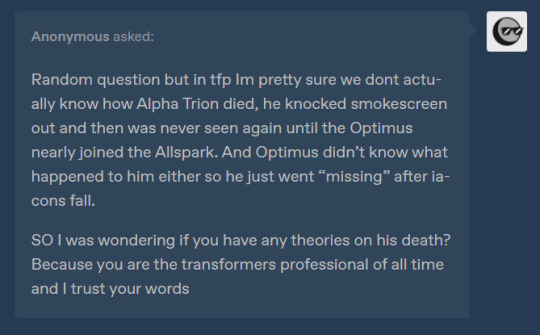
Ohhh nononnono- I am HARDLY a professional on this stuff- I'm fresh off the show and can barely remember anything 😅
But Alpha Trion.. I thought what happened was Smokescreen was protecting this building and it was about to be stormed by Decepticons. Smokescreen was ready to throw hands but then he got knocked out by Alpha Trion. A.T. then put the key in Smokescreens chest and... somehow he ended up in the cons ship.. but anyways- I thought after A.T. somehow got Smokey to safety- I thought those cons finally broke through the barriers and came in and killed A.T. ... is that not what happened..?

I've had an unfortunate amount of spoilers, and I don't like that I'm seeing/hearing.. but I'm holding off on any opinions until I see Markiplier play it.

@kaiserdarken
Perhaps he would! :0

As long as he got to keep his quilt on XDD
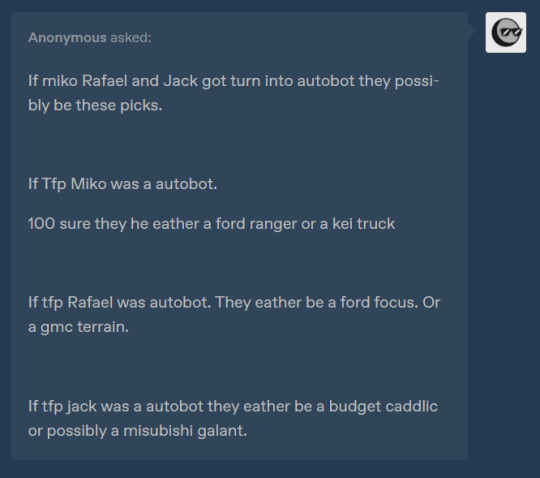
oooo those are all good choices! :00

(Referencing this post)
The big cheeto puff store!
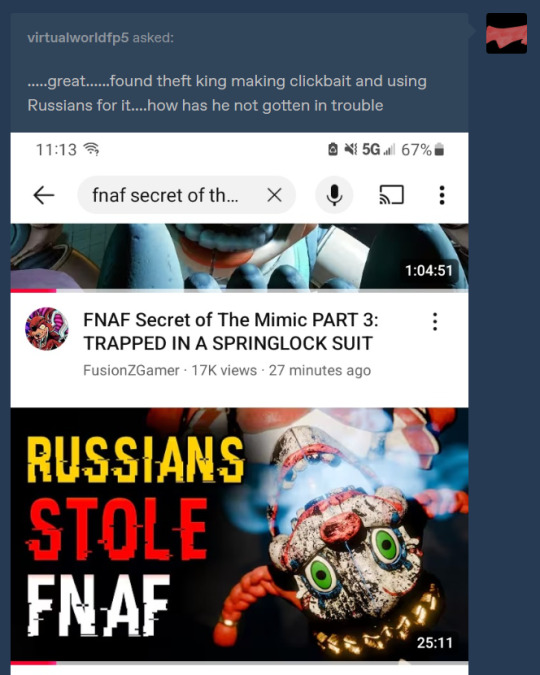
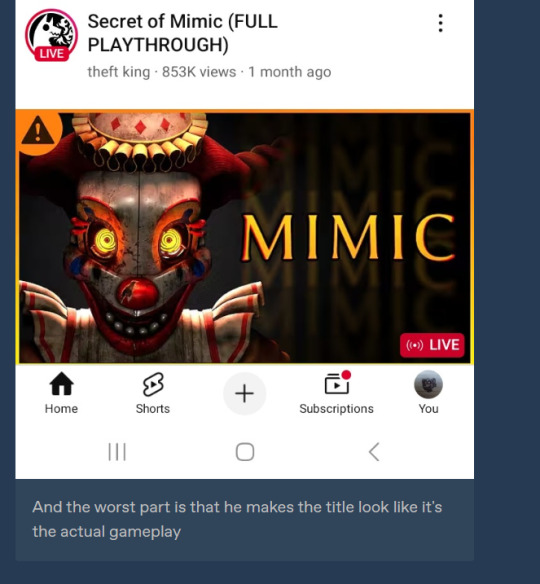
@virtualworldfp5
There is no part of this ask that I understand

Probably Jangles XDD
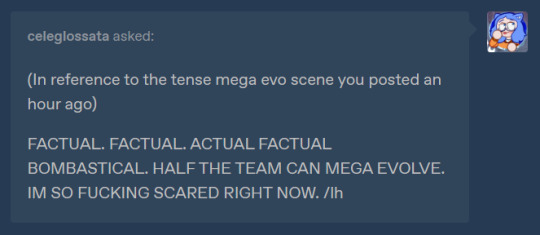
@celeglossata (Referencing this post)
<XD dw, there wasn't enough Mega bling to go around. But tbh Bonnie and Gloria should have played a bigger role considering the fact that can mega evolve too.
..ngl that's kind'a why I dropped the comic. I've sat on it long enough that looking back? I really don't like how I wrote it. And 237+ canvases is 1 too many to redraw. 💀
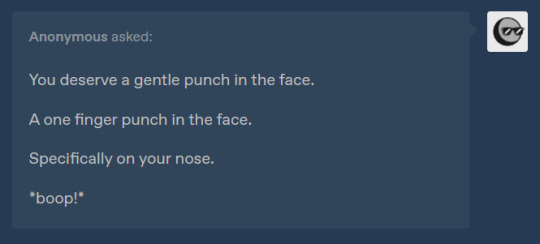
Suddenly you have 11 fingers

@i-only-created-this-to-read
I haven't thought about that actually.. but I CAN say that my Conkeldurr isn't supposed to be super old. He's about middle aged. Evolutions don't always relate to a Pokémon's age, as we have seen elderly first stage Pokémon before. :0 So that is to say there's a possibility that his parents are still alive. I just haven't really thought about it 😅

Will that get rid of my headache at least? 😔
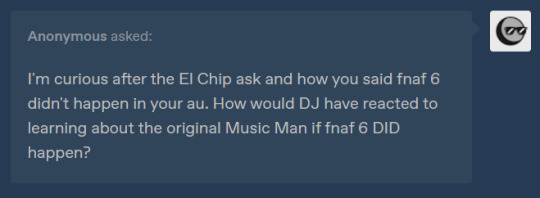
(El Chip ask)
I imagined he would be shocked to hear about another Music Man from another restaurant. In my AU- as far as I can remember- none of the Pizzaplex bots are aware there were other restaurants before them. So knowing that there are other Music Men in other establishments would be wild.

@cal-the-imp-artist
WAJHG THANK YOU SO MUCH!! 😭😭💞💞💞💞

@bunpiry
AAAA That's so cool!! :DDD I wonder which Pokémon you'll pick? 👀👀👀
(ALSO-- I hope you have a wonderful day too! :DD )

I've seen that Game theory and its sister channels have been making loads of videos on it, so I know it exists. But I haven't watched any of those videos. Its just not the same without MatPat.

Woof, that would have been wild. Never was a huge fan of that guy based on what I've seen. I wonder if I would have liked him less than Smokescreen..🤔
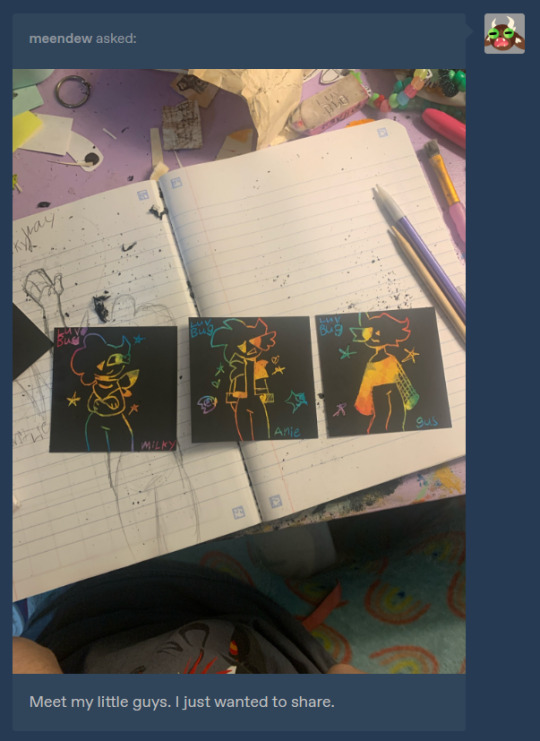
@meendew
Very cool! :DD

Its the song of his soul

Those would be some MAJOR googily eyes XDD

@beryl-shade
They might not, they wouldn't need to do it for the reasons cats do :0
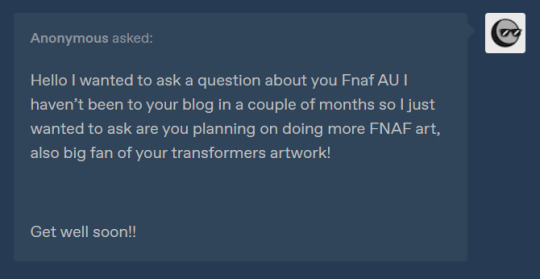
Thank you! And PLEASE re-read the ask button.
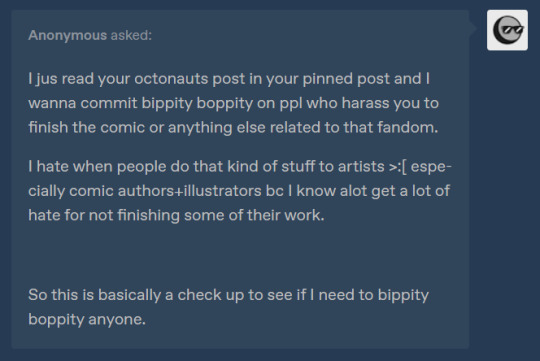
(Referring to this post)
<XD Thank youuu, and hey what ya gonna do. I'm always free to draw Octonauts in secret.

@glitchhayden418
XDD Thank youu, that means a lot! 😊
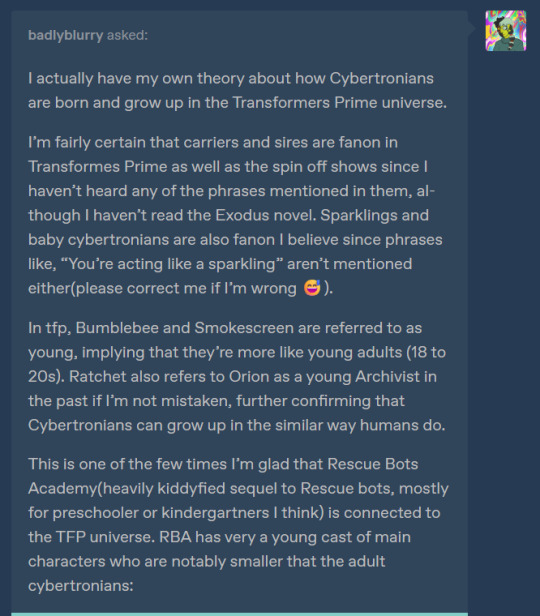
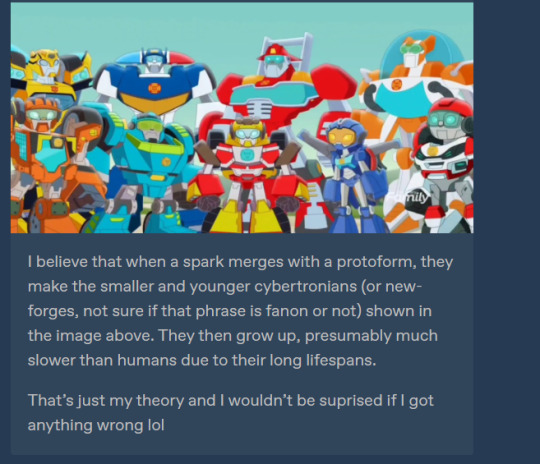
@badlyblurry
Oh yeah I've heard that theory floating around in one version or another- :00
I think for my AU tho, to save me having to research anything and to make it exactly the way I want, I'm just going to develop my own headcanons and method for how Cybertronians are made. I won't be doing the protoforms thing-
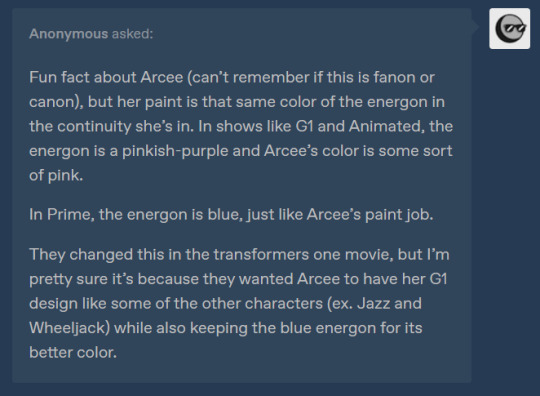
(Sent after makin this post)
Oooo I remember hearing about that. :00 Very metal. idk if this will be reason enough for me to keep her blue tho- I'd like to bring back her original color palette of pink/white. Even though TFP energon is blue--

@rainbowwatermelon7
AAAAA Thank you so much!! 🥰🥰🥰
#my response#transformers prime#fnaf security breach#fnaf secret of the mimic#factual fam#pokemon scarlet and violet#conkeldurr
43 notes
·
View notes
Text
Elevanco provides affordable UI/UX design services for startups, helping create intuitive and visually appealing digital products on a budget. Our expert team focuses on improving user engagement, increasing conversions, and building brand trust. Whether it's a website or mobile app, we offer scalable, cost-effective solutions tailored to your startup's needs. Contact us at +91-7388885426 today!
#Affordable UI/UX design services for startups#game development services in delhi#Custom game development solutions for startups#Top mobile game development companies near me#Game development services for educational apps#End-to-end game design and development solutions#Mobile Game Development Service#3D Game Development Service in delhi#2D Game Development#AR/VR Game Development#professional game developers for my project#Best game design and development solutions#Best game development tools for creating 3D games
0 notes
Text
🌟KIANAMAIART FAQ🌟
FAQ wahoooo!!

GENERAL QUESTIONS
Who are you?
I'm Kiana, I'm a queer, Japanese Jamaican woman, and a Director/Storyboard artist who works in animation. I'm currently at Disney Television Animation.
What are your pronouns?
I usually go by she/her but I don't really mind any pronouns~
Where did you go to school?
California College of the Arts (but I dropped out when I was hired at Disney)
How did you get hired at Disney?
My bosses found me on twitter. They liked my drawing style and asked if I wanted to take a storyboard test. I did, I passed, I got interviewed and moved to LA two weeks later to start storyboarding.
Your work seems familiar. What do I know you from?
I've been on the internet for a long time! It could be a number of things. As maimai97 on dA I had a comic about next gen Pokemon characters called Pokemon 25 Years Later. As kilala97 I had some popular next gen ponies and also had a Steven Universe gemsona named Larimar. I'm also @yamujiburo, known most for drawing Jessie x Delia (hanamusa) a lot. I also work professionally! I've worked as a storyboard artist and director on Disney Channel's Big City Greens, I was a storyboard artist on one of the Steven Universe anti-racism shorts and I was a storyboard artist on Pokemon: Path to the Peak. Most recently I've been on season 6 of Dropout's Game Changer!
What program and brush do you use to draw?
Default brush in Storyboard pro. Photoshop sometimes just for compositing or specific effects.
PPPIDWTBAMG QUESTIONS
What is this project?
This is a project that started off as a silly idea that has since grown into me creating a 10 minute pilot animatic.
What does "pilot animatic" entail?
It means that it's effectively a pilot/episode 1 of a (potential) larger series. It's fully voice acted but is not fully animated. It's an animatic, meaning it will be comprised of storyboards in video form.
When and where can I watch the pilot!?
Now and right here!
youtube
What would this series be rated?
Ideally like PG13/TV14! Or whatever they call it. Definitely more geared to a YA audience. Not completely kiddy but also not what most people would consider adult animation to be
What are you planning to do with the project now that the pilot has released?
Don't know yet! There has been a lot of studio interest and even offers, so I'm in the process of talking with them and seeing if I can find this show a home or if I want to try doing it on my own or if I want to even continue with it at all. I know you guys are curious, but even if I wanted to tell you I couldn't. Just trust that I will make announcements as they come~
You said Aika had teammates, will we see them?
Because of the studio interest and potential for more of this show, there's some stuff I'm still holding close to my chest. This is one of them.
Do the characters have parents??
Zira does! As for Aika and Eclipse, this is something I'm still developing and don't really know myself haha
What are the characters' sexualities?
Don't know right now. Headcanon away!
Is "Star Guardian: Guardian of the Stars" a reference to that vine?
Nope! It's more so a parody for just really long and redundant titles which I love. Similar to the title of this project, which is called "Pretty Pretty Please I Don't Want to be a Magical Girl"
3K notes
·
View notes
Text
There is no such thing as AI.
How to help the non technical and less online people in your life navigate the latest techbro grift.
I've seen other people say stuff to this effect but it's worth reiterating. Today in class, my professor was talking about a news article where a celebrity's likeness was used in an ai image without their permission. Then she mentioned a guest lecture about how AI is going to help finance professionals. Then I pointed out, those two things aren't really related.
The term AI is being used to obfuscate details about multiple semi-related technologies.
Traditionally in sci-fi, AI means artificial general intelligence like Data from star trek, or the terminator. This, I shouldn't need to say, doesn't exist. Techbros use the term AI to trick investors into funding their projects. It's largely a grift.
What is the term AI being used to obfuscate?
If you want to help the less online and less tech literate people in your life navigate the hype around AI, the best way to do it is to encourage them to change their language around AI topics.
By calling these technologies what they really are, and encouraging the people around us to know the real names, we can help lift the veil, kill the hype, and keep people safe from scams. Here are some starting points, which I am just pulling from Wikipedia. I'd highly encourage you to do your own research.
Machine learning (ML): is an umbrella term for solving problems for which development of algorithms by human programmers would be cost-prohibitive, and instead the problems are solved by helping machines "discover" their "own" algorithms, without needing to be explicitly told what to do by any human-developed algorithms. (This is the basis of most technologically people call AI)
Language model: (LM or LLM) is a probabilistic model of a natural language that can generate probabilities of a series of words, based on text corpora in one or multiple languages it was trained on. (This would be your ChatGPT.)
Generative adversarial network (GAN): is a class of machine learning framework and a prominent framework for approaching generative AI. In a GAN, two neural networks contest with each other in the form of a zero-sum game, where one agent's gain is another agent's loss. (This is the source of some AI images and deepfakes.)
Diffusion Models: Models that generate the probability distribution of a given dataset. In image generation, a neural network is trained to denoise images with added gaussian noise by learning to remove the noise. After the training is complete, it can then be used for image generation by starting with a random noise image and denoise that. (This is the more common technology behind AI images, including Dall-E and Stable Diffusion. I added this one to the post after as it was brought to my attention it is now more common than GANs.)
I know these terms are more technical, but they are also more accurate, and they can easily be explained in a way non-technical people can understand. The grifters are using language to give this technology its power, so we can use language to take it's power away and let people see it for what it really is.
12K notes
·
View notes
Text
I’ve been thinking a lot recently about storytelling vs. gameplay in Actual Play and finally had some solid thoughts coalesce around it when looking at Worlds Beyond Number and Thresher.
Thoughts after the cut:
This is going to be a hot take but I think, increasingly, Worlds Beyond Number is not an Actual Play but a collaborative audio novel/drama. While the margins between those things might seem on some level semantic, I think they’re really key for thinking about how Actual Play is different from other kinds of storytelling media. WBN was originally conceived of and advertised as “like the games you run in your living room” but as it has gone on the podcast has moved so far away from that that it is no longer delivering on that original conceit. This does not mean it is bad! I think WBN is actually succeeding more on a storytelling level as it sheds more of its obvious gameplay. But it’s gotten to a point where the game mechanics are either edited out and therefore not central to what is heard by the audience, or incidental to the story being told, which is driven far more by Brennan as the main worldbuilding storyteller than by game mechanics or player action. When a supposed Actual Play has a key narrative episode that finishes with almost 10 minutes of story narrated solely by the GM with no gameplay rolls or mechanics mentioned, of an epic, hugely narratively important combat, in my mind gameplay has taken enough of a backseat to the storytelling process that the podcast is no longer an Actual Play.
And I think we’ve seen an evolution over time of a lot of Actual Plays de-centering game mechanics or the conceit of gameplay in favor of more crafted narrative beats, to both the benefit and detriment of the stories themselves. In Critical Role for example, C1 and C2 in many ways felt more like a D&D game than C3, if only because of the presence of incidental, seemingly narratively insignificant combat moments. As late as late C2 with the Mighty Nein in Aeor, the players were rolling random encounters that had no relation to the larger endgame plot. This led some viewers to complain about pacing, but made other Actual Play enjoyers happy to the extent it showcased game mechanics and allowed character moments to emerge from the combat mechanics themselves, the core gameplay element of D&D. Contrast that to C3, which very early in the episode count did away with “meaningless” incidental combat and pushed forward with a very clear endgame narrative. I don’t think it’s a coincidence that fan engagement with mechanics really fell off in C3, with less meta about what spell or feat choices meant for character development. Similarly, the sunsetting of the CritRoleStats project, while certainly because founders were just busy and had put years into it already and were ready to move on, also was at least somewhat influenced by having less to work with as gameplay mechanics were emphasized less and less at the table in C3.
If you were to look at a lot of the more professional and academic study and critique of Actual Play, you might be convinced that a move away from centering gameplay and above table mechanics discussions was universally good for the medium, as an emphasis on storytelling over gaming would make it more universally accessible. I would posit though that at least some of this comes from the loudest, most professionally credentialed commentators on Actual Play coming from literature backgrounds, and therefore valuing storytelling and narrative over gaming for audience appeal. But I think that misses the gaming audience of Actual Play, who are less and less catered to as the medium becomes more mainstream.
There’s often not a lot of understanding of the appeal of gaming itself as an object of, especially curative, fan obsession, even as sports fandom exists as a huge example of the wide appeal. I am, pretty loudly, a baseball fan as well as a ttrpg and Actual Play fan. In many ways, these things hold similar appeal to me. I am interested in thinking about the game mechanics and action economy of certain character builds and how they fit into party composition in the same way I might obsess over a pitcher’s ERA and arsenal, as well as what his role is in the starting pitcher rotation or the bullpen. I find the prospect of a matchup between, say, Shohei Ohtani and Zack Wheeler appealing in the same way I’m excited about a mechanically strong D&D party fighting a Beholder. Gaming has long been interesting to people not only as something to participate in, but something to study and analyze. Win scenarios, optimal builds, and gameplay tactics are engaging to viewers as well as players. And I think, increasingly, Actual Play productions either forget this or, if the prevalence of editing gameplay out of edited AP is any indication, do not think the gameplay itself is of value or interest to the audience. Published Actual Play scholarship, in my opinion, continues to make this mistake as well. This has led to an increase of productions which are labeled as Actual Play and ostensibly have a gameplay component but are so far removed from watching/listening to people play a game that it is hard to argue that they are still Actual Play.
Which brings me to Thresher. Thresher was brilliant at threading that needle between production, radio drama vibes, and centered and narratively driving gameplay. I am someone who often complains about Actual Play production and editing doing Too Much but I actually loved the costumes and some of the editing gimmicks on Thresher because all of the storytelling and narrative was still so clearly grounded in the gameplay mechanics. Uses of drive mechanics and character abilities were clearly defined even as the audience could hold their breath in a tense horror atmosphere. Mechanics like Turn the Tide and Jasper’s move as the GM to allow the players to pass him secret notes were fantastic ideas to center player choice in crafting the narrative, and let the players surprise each other, leading to big and exciting moments a the table. The storytelling was enhanced by Abubakar’s above table exclamation of “what the fuck is this??” at the end, because it wasn’t just about the story that had unfolded but that his fellow players had surprised both him and the GM by using their game mechanic options to change the direction of the narrative and the condition of the story. I would love for more Actual Play to remember the value of the audience seeing that or being in on the extra-narrative elements of gameplay that shape story. Not all Actual Play needs to be the same, but I think we’ve lost something in the medium as a whole recently with a shift away from visible mechanics and toward streamlined, almost audio drama style story that just happens to have scaffolding from a tabletop roleplaying game.
#actual play#actual play meta#worlds beyond number#wbn pod#critical role#thresher#thresher cr#a surprising amount of baseball content for a post analyzing actual play
211 notes
·
View notes
Text
Astro observation ( part 1)


🔹For entertainment purposes only, enjoy🔹
♦️♦️♦️♦️♦️♦️♦️♦️♦️♦️♦️♦️
✨ Uranus in the first house individuals may reject authority or traditions that feels restrictive to them.others may seem them as trendsetters or avant -garde in their approach to life.
✨ Venus in the 10th house of natal chart peoples are so workaholic that they prioritise their career, success over personal relationships or self care.
✨ your spouse's name asteroid could fall in your natal 7th house. ( Not necessarily, but it can be).
✨ mercury in the 5th house can indicate a communicative and involved parenting style. This individuals may encourage their children's intellectual development, creativity, and curiosity, fostering a supportive environment that values self expression and learning.
✨ Scorpio mars individuals have a strong sense of loyalty and protectiveness towards their loved ones. They can be fiercely protective of those they care about and may go to great lengths to defend and support them.
✨ regulus in 7th house of Composite chart - your relationship with your person may bring some fame/ recognition.
✨ Astrocartography mc lines - indicates which place may have a significant impact on your career or public life.
✨ Astrocartography Dc lines - you may meet your spouse/ long term partner there.
✨ Saturn in the 4th house individuals are very traditional 🙂
✨ solar return Jupiter/ mercury in 3rd house/ 10th house may indicate favorable year for cracking competitive exams.
✨ Earth dominate individuals may admire partners who take their commitments seriously whether it's in personal relationships ,career or other areas of life.

✨ juno in 1st house of groom persona chart means your spouse may influence how you present yourself to others or how you are perceived in social settings. they could bring out certain qualities in you or play a significant role in shaping your public image.
✨ South node lines in your Astrocartography chart indicates where you lived in your past lives.
✨ Briede conjunct Devine asteroid in synastry - divine/ fated relationship.
✨ Union asteroid in your groom / briede pc can indicate where you will meet your potential life partner/ spouse :
♾️ Union in Aries - dynamic / stimulating environments suggest adventurous activities, sports events, or places that involved risk taking and exploration. Gyms, fitness classes, martial art studios, organizing events , can meet through social gatherings / casual meet ups where people gather for fun or socializing. , Business conferences/ academic competitions.
♾️ Union in Taurus -
Fine dining restaurants , art galleries/ elegant social events. Settings related to finance, banking, investments , or business networking events., Exhibitions , concerts, musical performance, through mutual friends, wellness workshops.
♾️ Union in gemini -
Intellectual or educational events, workshops, seminars, book clubs , social gatherings , parties , online platforms, social media, dating apps, local festivals , neighborhood gatherings , during travel, airport, train station, writing workshop, media production, related to communication and journalism.
♾️ Union in cancer -
Family gatherings , reunions, hospitals , caregiving facilities, charity events , volunteering activities, through mutual friends, at historical sites, museums, art galleries, cultural events, small town festivals, near Lake, river, beaches, cafe , restaurant.
♾️ Union in leo -
Theatres , music venues, art galleries, or during performances and artistic events, parties , weddings, festivals , or grand gathering, acting class, outdoor festival, sports event , amusement park, related to child's education, youth organization, casinos, comedy clubs , gaming centre etc.
♾️ Union in Virgo -
Office , workplaces, professional conferences, networking events, volunteer activities, community service projects, charitable organisations, gyms, fitness classes health food store, wellness center, university, school , educational seminars, pet adoption events, parks , botanical garden.
♾️ Union in Libra -
Social getherings, parties, networking events, through mutual friends, concerts, cultural events, museums, theatre performance, settings related to law, mediation or during discussions that involve finding mutual agreements or resolutions., Teamwork, collaboration, relationship focused workshop,fashion shows, design exhibition, cocktail party, formal gatherings, courtroom, law office.
♾️ Union in scorpio -
Psychotherapy session, support groups, detective work, reasearch fields or in setting that require deep analysis and understanding., Spiritual retreats, metaphysical shops, astrology or tarot classes, tantra workshop, relationship councilling, setting related to investment, joint ventures, estate planning, holistic health centres , transformational workshop, place focused on healing practices.
♾️ Union in Sagittarius -
Travel, airport, train station, in foreign countries, or while participating in adventures such as hiking, backpacking, or exploring new cultures, University, libraries, seminars, religious gatherings, philosophy group, outdoor activities, sports events, camping trips, cultural festival, international events, language exchange program, law, publishing house, that promotes justice.
♾️ Union in Capricorn -
Office, corporate events, buisness conference, while pursuing ambitious projects, leadership roles, ceremony, cultural events, context related to banking, investments, Financial setting, teaching activities , prestigious club , organization, or during events where recognition and achievements are celebrated., Formal dinner etc.
♾️ Union in Aquarius -
Activism, volunteer work, community organization, seminars, conferences, discussion groups, online platforms, social media, tech startups, through mutual friends, social circles, online communities, music festival, Charity work.
♾️ Union in Pisces -
May meet in spiritual retreats, meditation centre, yoga studio, art galleries, theatre, music concert, poetry reading,film screening , volunteer work, charitable organisations, near Lake , beaches , hospital, clinic, wellness center, music festival, dance class, spiritual chants or ceremonies, book clubs focused on fiction on fantasy genres.
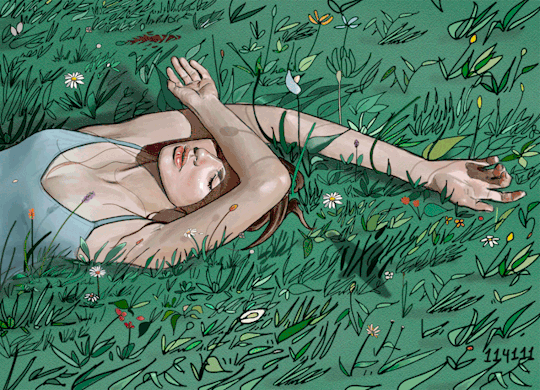
✨ Saturn in 1st house people often have RBF / Serious demeanor 👺
✨ Moon opposite/ square Saturn in solar return chart indicates emotional heaviness, feeling of loneliness or responsibilities weighing heavily on the emotions 😭.
✨ Jupiter/ Venus in 2nd house of Groom/ Briede pc indicates rich spouse.
✨ South node conjunct karma in synastry might suggest past life conflicts, power struggles or intense experiences that need healing or resolution in the current lifetime.

My other posts :
🔮 your future spouse's career.
🔮 your past life.
🔮 marriage placement in synastry and composite.
And many more on my page-
See you soon ~
- Piko ✨
#astro community#astro notes#astro observations#astrology#astro placements#composite#composite chart#synastry aspects#synastry#synastry observations#asteroid#love and deepspace#future spouse#future husband#future#juno persona chart#juno astrology#briede persona chart#groom persona chart#ask blog
763 notes
·
View notes
Text
Absolutely heartbroken by the news of Trick and Karin Weekes being laid off from Bioware by EA. They were the last true veterans and original creators of DA that were still there, and this truly feels like the final nail in the coffin for beloved studio and franchise.
The way EA systematically drained and destroyed this studio and the franchise too over the years is nothing short of criminal! it all started with that cursed Anthem, than pushing Bioware to make the kind of games it doesn't want to, scraping amazing projects, putting them through decade of development hell, chasing away half of original veteran devs and professionals, and laying off the other half over last few years.. EA's CEO talking bout how AI is at the core of their business six months ago.... It all makes me sick to my stomach! At this point I will never give another cent to EA for anything. DA franchise might be over but lives on in our hearts and through our art and fics and love for this characters and the world. that's what we have left and they can't take away from us. I hope EA crashes and burns in every way possible.
Thank you Trick Weekes for everything.. their writing credits speak for themselves....
Mass Effect (Writer) Dragon Age:Origins (Additional Design) Mass Effect 2 (Writer) Mass Effect 2: Lair of the Shadow Broker (Writer) Mass Effect 3 (Senior Writer) Mass Effect 3: From Ashes (Writer) Mass Effect 3: Leviathan (Writer) Mass Effect 3: Citadel (Writer)
Wrote characters like Garrus, Kasumi, Tali, Mordin, Legion, Jack, Joker…
Dragon Age Inquisition (Writer) - wrote "Wicked Eyes Wicked Hearts" and "Here Lies the Abys", wrote Solas, Cole, Iron Bull and the Chargers, also worked on minor npc's and codex entries and lore
Dragon Age Inquisition - Jaws of Hakkon DLC (Lead Writer) Dragon Age Inquisition - Trespasser DLC (Lead Writer) Dragon Age: The Veilguard (Lead Writer)
Dragon Age: Masked Empire - single-handedly wrote full novel and created Felassan as original character Dragon Age: Tevinter Nights - "Three Trees to Midnight" and "The Dread Wolf Take You"
💔💔💔💔
#f...k EA!!!#trick weekes#karin weekes#bioware#dragon age#mass effect#dragon age origins#dragon age inquisition#dragon age veilguard#dav#datv
258 notes
·
View notes
Text
Dragon Age: The Veilguard: Strangled by Gentle Hands
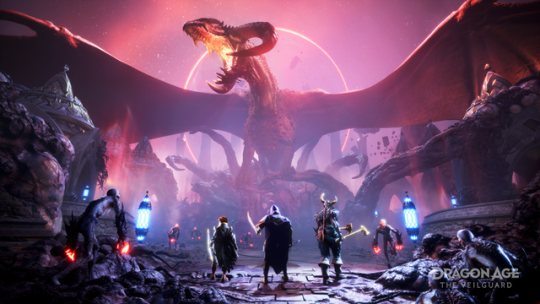
*The following contains spoilers*
“You would risk everything you have in the hope that the future is better? What if it isn’t? What if you wake up to find the future you shaped is worse than what was?”
– Solas, Dragon Age: Inquisition (2014)
I. Whatever It Takes
My premium tickets for a local film festival crumpled and dissolved in my pants pocket, unredeemed as they swirled in the washing machine. Throughout that October weekend in 2015, I neglected my celebratory privileges, my social visits to friends, and even my brutal honors literary theory class. All because a golden opportunity stretched before me: a job opening for a writing position at the once-legendary BioWare, with an impending deadline.
The application process wasn’t like anything I’d seen before. Rather than copy+paste a cover letter and quickly swap out a couple of nouns here and there, this opening required me to demonstrate my proficiency in both words and characters – namely, BioWare’s characters. Fanfiction wasn’t normally in my wheelhouse – at the time, I had taken mainly to spinning love sonnets (with a miserable success rate). But I wouldn’t balk at this chance to work on one of my dream franchises – especially since the job prospects for fresh English BAs weren’t exactly promising. So, I got to work crafting a branching narrative based on the company’s most recent title: Dragon Age: Inquisition. Barely two months prior, I saw the conclusion of that cast’s story when the Inquisitor stabbed a knife into a map and swore to hunt her former ally, Solas, to the ends of the earth. Now it was my turn to puppeteer them, to replicate the distinct voice of each party member and account for how they’d react to the scenario I crafted. And if it went well, then maybe I’d be at the tip of the spear on that hunt for Solas. Finishing the writing sprint left me exhausted, but also proud of my work.
The folks at BioWare obviously felt differently, because I received a rejection letter less than a week later. Maybe they found my story trite and my characterization inaccurate, or maybe they just didn’t want to hire a student with no professional experience to his name. Regardless, I was devastated. It wouldn’t be until years later that I learned that, had my application been accepted, I likely would’ve been drafted into working on the studio’s ill-fated looter shooter, Anthem (2019), noteworthy for its crunch and mismanagement. My serendipitous rejection revealed that sometimes the future you strive to build was never meant to match your dreams. What seemed like an opportunity to strike oil actually turned out to be a catastrophic spill.
Still, my passion for the Dragon Age series (as well as Mass Effect) persisted in the face of BioWare’s apparent decline. I maintain that Inquisition is actually one of the studio’s best games, and my favorite in the series, to the point where I even dressed up as Cole for a convention one time. The game came to me at a very sensitive time in my life, and its themes of faith vs falsehood, the co-opting of movements in history, and the instability of power all spoke to me. But I will elaborate more on that at a later date. My point is, I held on to that hope that, in spite of everything, BioWare could eventually deliver a satisfactory resolution to the cliffhanger from their last title. Or perhaps it was less hope and more of a sunk cost fallacy, as an entire decade passed with nary a peep from Dragon Age.
As years wore on, news gradually surfaced about the troubled development of the fourth game. Beginning under the codename “Joplin” in 2015 with much of the same creative staff as its predecessors, this promising version of the game would be scrapped two years later for not being in line with Electronic Arts’s business model (i.e. not being a live-service scam). Thus, it was restarted as “Morrison”. The project cantered along in this borderline unrecognizable state for a few years until they decided to reorient it back into a single-player RPG, piling even more years of development time onto its shaky Jenga tower of production. Indeed, critical pieces were constantly being pulled out from the foundations during this ten year development cycle. Series regulars like producer Mark Darrah and director Mike Laidlaw made their departures, and the project would go on to have several more directors and producers come and go: Matthew Goldman, Christian Dailey, and Mac Walters, to name a few key figures. They eventually landed on John Epler as creative director, Corinne Busche as game director, and Benoit Houle as director of product development. Then came the massive layoffs of dozens of employees, including series-long writer Mary Kirby, whose work still made it into the final version of DA4. Finally, the game received a rebranding just four months before release, going from Dreadwolf (which it had been known as since 2022) to The Veilguard (2024) – a strange title with an even stranger article.
Needless to say, these production snags did not inspire confidence, especially considering BioWare’s been low on goodwill between a string of flops like Anthem and Mass Effect: Andromeda (2017) and, before that, controversial releases like Dragon Age II (2011) and Mass Effect 3 (2012). The tumult impacted The Veilguard’s shape, which scarcely resembles an RPG anymore, let alone a Dragon Age game. The party size is reduced from four to three, companions can no longer be directly controlled, the game has shifted to a focus on action over tactics a la God of War (2018), the number of available abilities has shrunk, and there’s been a noticeable aesthetic shift towards a more cartoonish style. While I was open to the idea of changing up the combat (the series was never incredible on that front), I can’t get over the sensation that these weren’t changes conceived out of genuine inspiration, but rather vestigial traces from the live-service multiplayer iteration. The digital fossil record implies a lot. Aspects like the tier-based gear system, the instanced and segmented missions, the vapid party approval system, the deficit of World State import options, and the fact that rarely does more than the single mandatory companion have anything unique to say on a quest – it all points to an initial design with a very different structure from your typical single-player RPG. The Veilguard resembles a Sonic Drive-In with a mysterious interior dining area – you can tell it was originally conceived as something else.1
That said, the product itself is functional. It contains fewer bugs than any previous game in the franchise, and maybe BioWare’s entire catalog for that matter. I wouldn’t say the combat soars, but it does glide. There’s a momentum and responsiveness to the battle system that makes it satisfying to pull off combos and takedowns against enemies, especially if you’re juggling multiple foes at once. Monotony sets in after about thirty or forty hours, largely due to the fact that you’re restricted to a single class’s moveset on account of the uncontrollable companions. Still, this design choice can encourage replay value, as it does in Mass Effect, and free respec options and generous skill point allocations offset the tedium somewhat.
While the character and creature designs elicit controversy – both for the exaggerated art direction and, in the case of demons and darkspawn, total redesign – the environmental art is nothing short of breathtaking. I worried that this title would look dated because of how long it had been in development and the age of the technology it was built upon. Those fears were swiftly banished when I saw the cityscapes of Minrathous, the cyclopean architecture of the Nevarran Grand Necropolis, or the overgrown ruins of Arlathan. But like everything in The Veilguard, it’s a double-edged sword. The neon-illuminated streets of Docktown, the floating citadel of the Archon’s Palace, and the whirring mechanisms of the elven ruins evoke a more fantastically futuristic setting that feels at odds with all three previous titles (even though all three exhibited a stylistic shift to some extent). It aggravates the feeling of discordance between this rendition of Thedas and the one returning players know.

All of these elements make The Veilguard a fine fantasy action-adventure game – even a good one, I’d say. But as both the culmination of fifteen years of storytelling and as a narrative-based roleplaying game – the two most important facets of its identity – it consistently falls short. Dragon Age began as a series with outdated visuals and often obtuse gameplay, but was borne aloft by its worldbuilding, characterization, and dialogue. Now, that paradigm is completely inverted. The more you compare it to the older entries, the more alien it appears. After all these years of anticipation, how did it end up this way? Was this the only path forward?
Throughout The Veilguard’s final act, characters utter the phrase “Whatever it takes,” multiple times. Some might say too many. I feel like this mantra applied to the development cycle. As more struggles mounted, the team made compromise after compromise to allow the game to exist at all, to give the overarching story some conclusion in the face of pressure from corporate shareholders, AAA market expectations, and impatient fans. Whatever it takes to get this product out the door and into people’s homes.
This resulted in a game that was frankensteined together, assembled out of spare parts and broken dreams. It doesn’t live up to either the comedic heights or dramatic gravity of Inquisition’s “Trespasser” DLC from 2015, despite boasting the same lead writer in Trick Weekes. Amid the disappointment, we’re left with an unfortunate ultimatum: It’s either this or nothing.
I don’t mean that as a way to shield The Veilguard from criticism, or to dismiss legitimate complaints as ungrateful gripes. Rather, I’m weighing the value of a disappointing reality vs an idealized fantasy. The “nothing”, in this sense, was the dream I had for the past decade of what a perfect Dragon Age 4 looked like. With the game finally released, every longtime fan has lost their individualized, imaginary perfection in the face of an authentic, imperfect text. Was the destruction of those fantasies a worthy trade? It doesn’t help that the official artbook showcases a separate reality that could’ve been, with a significant portion dedicated to the original concepts for Joplin that are, personally, a lot closer to my ideal vision. I think it would’ve done wonders to ground the game as more Dragon Age-y had they stuck with bringing back legacy characters, such as Cole, Calpernia, Imshael, and the qunari-formerly-known as Sten.

I don’t necessarily hate The Veilguard (I might actually prefer it to Dragon Age II), but I can’t help but notice a pattern in its many problems – a pattern that stems from a lack of faith in the audience and a smothering commitment to safety over boldness. As I examine its narrative and roleplaying nuances, I wish to avoid comparing it to groundbreaking RPGs such as Baldur’s Gate 3 (2023) or even Dragon Age: Origins (2009), as the series has long been diverging from that type of old-school CRPG. Rather, except when absolutely necessary, I will only qualitatively compare it to Inquisition, its closest relative.
And nowhere does it come up shorter to Inquisition than in the agency (or lack thereof) bestowed to the player to influence their character and World State.
II. Damnatio Memoriae
No, that’s not the name of an Antivan Crow (though I wouldn’t blame you for thinking so, since we have a character named “Lucanis Dellamorte”). It’s a Latin phrase meaning “condemnation of memory”, applied to a reviled person by destroying records of their existence and defacing objects of their legacy. In this case, it refers to the player. When it comes to their influence over the world and their in-game avatar, The Veilguard deigns to limit or outright eliminate it.
Save transfers that allow for the transmission of World States (the carrying over of choices from the previous games) have been a staple of the Dragon Age and Mass Effect franchises. Even when their consequences are slight, the psychological effect that this personalization has on players is profound, and one of many reasons why fans grow so attached to the characters and world. At its core, it’s an illusion, but one that’s of similar importance to the illusion that an arbitrary collection of 1s and 0s can create an entire digital world. Player co-authorship guarantees a level of emotional investment that eclipses pre-built backgrounds.
However, The Veilguard limits the scope to just three choices, a dramatic decrease from the former standard. All import options come from Inquisition, with two just from the “Trespasser” expansion. One variable potentially impacts the ending, while the other two, in most cases, add one or two lines of dialogue and a single codex entry. Inquisition, by contrast, imported a bevy of choices from both previous games. Some of them had major consequences to quests such as “Here Lies the Abyss” and “The Final Piece”, both of which incorporated data from two games prior. The Veilguard is decidedly less ambitious. Conspicuously absent options include: whether Morrigan has a child or not, the fate of Hawke, the status of the Hero of Fereldan, the current monarchs of Fereldan and Orlais, the current Divine of the southern Chantry, and the individual outcomes of more than two dozen beloved party members across the series. Consequently, the fourth installment awkwardly writes around these subjects – Varric avoids mentioning his best friend, Hawke, as does Isabela ignore her potential lover. Fereldan, Orlais, and the Chantry are headed by Nobody in Particular. Morrigan, a prominent figure in the latest game, makes no mention of her potential son or even her former traveling companions. And the absence of many previous heroes, even ones with personal stakes in the story, feels palpably unnatural. I suspect this flattening of World States into a uniform mold served, in addition to cutting costs, to create parity between multiple cooperative players during the initial live-service version of Morrison. Again, the compromises of the troubled production become apparent, except this time, they’re taking a bite out of the core narrative.
Moreover, the game’s unwillingness to acknowledge quantum character states means that it’s obliged to omit several important cast members. At this point, I would’ve rather had them establish an official canon for the series rather than leaving everything as nebulous and undefined as possible. That way at least the world would’ve felt more alive, and we could’ve gotten more action out of relevant figures like Cassandra, Alistair, Fenris, Merrill, Cole, and Iron Bull. Not to mention that The Veilguard’s half-measure of respectful non-intereference in past World States ultimately fails. Certain conversations unintentionally canonize specific events, including references to Thom Rainier and Sera, both of whom could go unrecruited in Inquisition, as well as Morrigan’s transformation into a dragon in the battle with Corypheus in that game’s finale. But whatever personal history the player had with them doesn’t matter. The entire Dragon Age setting now drifts in a sea of ambiguity, its history obfuscated. It feels as gray and purgatorial as Solas’s prison for the gods.
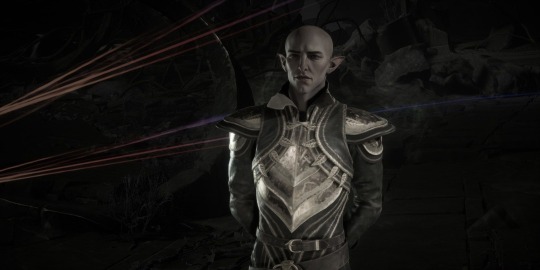
Beyond obscuring the past, The Veilguard restrains the player’s agency over the present. When publications first announced that the game would allow audiences to roleplay transgender identities and have that acknowledged by the party, I grew very excited – both at the encouraging representation, and at the depth of roleplaying mechanics that such an inclusion suggested. Unfortunately, The Veilguard offers little in roleplaying beyond this. The player character, Rook, always manifests as an altruistic, determined, friendly hero, no matter what the player chooses (if they’re offered choices at all). The selections of gender identity and romantic partner constitute the totality of how Rook defines themselves, post-character creation – exceptions that prove the rule of vacancy. Everything else is set in stone. The options presented are good, and should remain as standard, but in the absence of other substantive roleplaying experiences, their inclusion starts to feel frustratingly disingenuous and hollow, as if they were the only aspects the developers were willing to implement, and only out of obligation to meet the bare minimum for player agency. In my opinion, it sours the feature and exudes a miasma of cynicism.
Actual decisions that impact the plot are few and far between, but at least we have plenty of dialogue trees. In this type of game, dialogue options might usually lead to diverging paths that eventually converge to progress the plot. You might be choosing between three different flavors of saying “yes”, but as with the World States, that illusion of agency is imperative for the roleplaying experience. The Veilguard doesn’t even give you the three flavors – the encouraging, humorous, and stern dialogue options are frequently interchangeable, and rarely does it ever feel like the player is allowed to influence Rook’s reactions. Relationships with companions feel predetermined, as the approval system has no bearing on your interactions anymore. There are so few moments for you to ask your companions questions and dig in deep compared to Inquisition. Combined together, these issues make me question why we even have dialogue with our party at all. Rook adopts the same parental affect with each grown adult under their command, and it feels like every conversation ends the same way irrespective of the player’s input. With the exception of the flirting opportunities, they might as well be non-interactive cutscenes.
Rook’s weak characterization drags the game down significantly. With such limited authorship afforded to the player, it’s difficult to regard them as anything more than their eponymous chess piece – a straightfoward tool, locked on a grid, and moving flatly along the surface as directed.
III. Dull in Docktown
On paper, a plot summary of The Veilguard sounds somewhere between serviceable and phenomenal: Rook and Varric track down Solas to stop him from tearing down the Veil and destroying the world. In the process, they accidentally unleash Elgar’nan and Ghilan’nain, two of the wicked Evanuris who once ruled over the elven people millenia ago. With Solas advising them from an astral prison, Rook gathers a party together to defeat the risen gods, along with their servants and sycophants. Over the course of the adventure, they uncover dark truths about the origins of the elves, the mysterious Titans, and the malevolent Blight that’s served as an overarching antagonistic force. Eventually, Rook and friends join forces with Morrigan and the Inquisitor, rally armies to face off with their foes, and slay both the gods and their Archdemon thralls before they can conjure the full terror of the Blight. As Solas once again betrays the group, Rook and company have to put a decisive stop to his plans, which could potentially involve finally showing him the error of his ways.
The bones of The Veilguard’s story are sturdier than a calcium golem. Problems arise when you look at the actual writing, dialogue, and characterization – the flesh, blood, and organs of the work.

I’ve seen others chide the writing as overly quippy, but that better describes previous titles. Rather, I think The Veilguard’s dialogue is excessively utilitarian and preliminary, like a first draft awaiting refinement. Characters describe precisely what’s happening on screen as it’s happening, dryly exposit upon present circumstances, and repeat the same information ad nauseum. This infuriating repetition does little to reveal hidden components of their personalities, or their unique responses to situations. You won’t hear anything like Cole’s cerebral magnetic poetry or Vivienne’s dismissive arrogance. Many exchanges could’ve been uttered by Nobody in Particular, as it’s just dry recitation after recitation. It almost feels like watching an English second language instructional video, or a demonstration on workplace safety precautions. Clarity and coherence come at the cost of characterization and charisma.
Words alone fail to make them interesting. Most companions lack the subtlety and depth I had come to expect from the franchise, with many conversations amounting to them just plainly stating how they’re feeling. Most rap sessions sound like they’re happening in a therapist’s office with how gentle, open, and uncomplicated they feel. Compare this to Inquisition, where every character has a distinct voice (I should know, I had to try to copy them for that stupid application), as well as their own personal demons that it betrays: Sera’s internalized racism, hints of Blackwall’s stolen valor, Iron Bull’s espionage masked by bluster, or Solas’s lingering guilt and yearning for a bygone age. These aspects of their characters aren’t front and center, but things the audience can delve into that gives every moment with them more texture. The Veilguard’s companions lay out all their baggage carefullly and respectfully upfront, whether it’s Taash’s multiculturalism and gender identity issues or Neve’s brooding cynicism towards Tevinter’s underbelly. You’ve plumbed the depths of their personas within the first few minutes of meeting most of them.
Small exceptions exist. Professor Emmerich Volkarin stands out from the rest of the cast as a particularly inspired character: a charming, Vincent Price-like necromancer. His attachment to tombs and necromancy as a way to cope with his crippling fear of death makes for curiously compelling melodrama. The way in which he ultimately has to face his fear – either by foregoing his opportunity for immortality to save his beloved skeletal ward, Manfred, or by allowing his friend to pass on so that he can transcend into a new type existence – rises above the other binary choices in the game by being both narratively interesting and legitimately difficult to judge. Still, I feel Emmerich’s whole “lawful good gentleman necromancer” conceit, while a unique and clever subversion of tropes, would’ve worked better if it actually contrasted with anyone else in the party. Instead, the whole crew is full of unproblematic do-gooders who are forbidden by the game to nurture any meaningful interpersonal conflict. While I’d appreciate this lack of toxicity in my real-life relationships, fictional chemistry demands more reactive ingredients.

The Veilguard’s developers frequently positioned the game as “cozy” and about a “found family”, but I can guarantee you that there’s more tension at my Thanksgiving dinners than there is anywhere in this title. This family would get along swimmingly even during a presidential election. The thing about the “found family” trope is that it’s more satisfying when it’s earned. Here, it represents the default state, the starting point, and the status quo that they will always return to. Any minor squabbles (Harding wanting to sleep in the dirt, Emmerich taking too many books on a camping trip, Taash not liking necromancy) are introduced and squashed within the same scene. They all feel so extraneous. There’s so little friction among the companions here that you’d think it disproves Newton’s Third Law. The previous games never struggled in this regard, which makes the choices here all the more baffling.
Beyond the intra-party dynamics, characters lack grit or darkness to them – even when the narrative absolutely calls for it. Remember how I described the necromancer as lawful good (to use traditional Dungeons and Dragons alignments)? Yeah, that’s every character. Even the demonic assassin. Lucanis is a notorious hitman possessed by a demon of Spite, and possibly the weakest character of the game. This may or may not be due to the fact that his writer, Mary Kirby, was laid off mid-development. Regardless, he has noticeably less content than the other party members and generally feels unfinished. The demonic possession storyline goes nowhere; he doesn’t exorcise Spite, nor does he learn more about it or how to live with it. Instead, Spite is just an excuse to give Lucanis cool spectral wings (which he will use to fail several assassination attempts). The demon itself mostly just comes across as rude rather than threatening. The biggest issue, however, stems from the absence of any edge to Lucanis. When confronting his traitorous cousin, Ilario – the man who sold out Lucanis’s family to an enemy faction, kidnapped his grandmother, and made multiple attempts on his life – our grizzled, hardened assassin, pushed to the brink, demands… due process. Seriously, if your choices have led Lucanis to have a hardened heart, his method for dealing with the grievous traitor is sending him to jail. That’s The Veilguard’s idea of vindictive brutality among a clan of unforgiving murderers-for-hire. By contrast, Inquisition features Sera insubordinately murdering a stuck-up nobleman for talking too much. I believe that if modern BioWare had written The Godfather (1972), it would’ve ended with Michael Corleone recommending his brother-in-law to attend confession and seek a marriage counselor.
The writers seem intent on making the cast wholly unproblematic, with no way that the audience could ever question their morality or taste the delicious nuance of seeing someone you like do something bad. Measures were taken to child-proof every aspect of the good guys so that they couldn’t possibly be construed as anything else – even if it constricts them to the point of numbness and eventual atrophy.
To make things as palatable and accessible as possible, the language itself was dumbed down. Characters make frequent use of neologisms and bark phrases like “Suit up,” or “These guys go hard.” It emulates popular blockbuster superhero stuff rather than staying true to the diction the series traditionally employed. It’s all about the team, and the entire Dragon Age world has been stripped down into simplistic conflicts and recognizable stock characters.
This is why The Veilguard’s story largely fails. Despite being ostensibly being about the characters, they come off as an afterthought. Most of the time, only the sole requisite follower has anything to say on a given mission. Even in combat, their wholeness as fully-implemented party members falls short of expectations. Their damage output pales in comparison to the Rook’s, they have no health and cannot be downed in battle, and they mainly exist to give the player three extra ability slots. That’s the game’s true ethos for the companions, whether in combat or dialogue – utility, tools to make things happen rather than elegantly crafted identities. We end up with the largest amount of content per companion among any game in the franchise, only to have the weakest roster.
I know these writers can do better, because I’ve seen them do better. Trick Weekes wrote Iron Bull, Cole, and Solas in Inquisition, as well as Mordin Solus and Tali’Zorah in Mass Effect 2 (2010) and Mass Effect 3. Mary Kirby wrote Varric throughout the series, as well as Sten and Loghain in Origins. Plenty of other experienced writers, such as Sylvia Feketekuty and John Dombrow also contributed, so I can’t put any of the blame on a lack of skill. I don’t know if the mistake was trying to appeal to a wider audience, or if the constant reorientations of the DA4 project drained the crew’s passion and left them lacking in time to polish things.
I personally suspect that the writers had to rush out a script for all of the voiced dialogue. A video from August of 2020 showed off the voice actors for Davrin and Bellara, more than four years before the final game’s release. I think the codex entries, letters, and missives that you find throughout the game, which consist of only text, are much better written than the dialogue. My theory is that the writers had more time to revise and spruce up these tidbits, where edits were minimally invasive, as far as production is concerned. But my knowledge is limited; after all, BioWare rejected my application almost a decade ago.
Still, there are aspects of The Veilguard’s plot that I enjoy. The lore reveals were particularly satisfying2, and many felt rewarding after a decade of speculation. I called that elves were originally spirits, as well as the connection between the Archdemons and the Evanuris, but I wouldn’t have guessed that the Blight formed out of the smoldering rage of the Titans’ severed dreams. I’d concisely describe The Veilguard’s story as the opposite of Mass Effect 3: Whereas ME3 did excellent character work, the characterization in The Veilguard leaves much to be desired. Whereas ME3’s tone was overwhelmingly grim, The Veilguard feels inappropriately positive. Whereas ME3’s lore reveals ruined much about the series’s mystique, The Veilguard’s helped tie the setting’s history together. And whereas ME3 fumbled the ending about as much as it possibly could, The Veilguard actually coalesces into a spectacular third act.
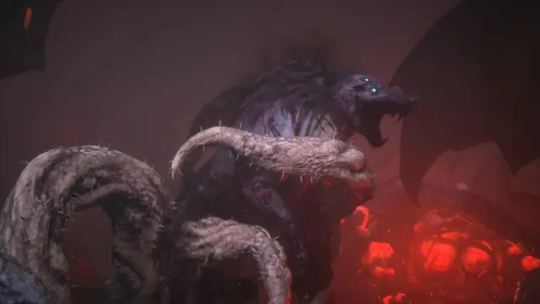
While I think the twist with Varric’s death is weak (outright pitiful compared to the Dread Wolf twist of Inquisition), the actual events that make up the finale carry a momentum and urgency that the rest of the game severely lacked. Everything from the sacrifice and kidnapping of Rook’s companions to the slaying of Ghilan’nain to the awe-inspiring battle between the Dread Wolf and Archdemon Lusacan – the whole affair takes the best parts of Mass Effect 2’s Suicide Mission and elevates it to the scale of an apocalyptic series finale. Ultimately, Solas takes center stage as the final antagonist, and the drama crescendos to a height the rest of the game desperately needed. He remains the most interesting character in the game and perhaps the franchise, and thankfully, the resolution to his story did not disappoint me (though I would’ve preferred the option for a boss battle against his Dread Wolf form if the player’s negotiations broke down). So in that sense, I think the worst possible scenario was avoided.
But is that really worth celebrating? Averting complete disaster? Exceeding the lowest standards? In many regards, The Veilguard still could have been – should have been – more.
IV. A World of Tranquil
In my essay on Final Fantasy VII: Rebirth (2024), I briefly discussed a trend in media to sand off the edges so as not to upset the audience in any way. The encroachment of this media sanitization seems to be an over-correction to the brimming grimness of late 2000s and early 2010s fiction (to which the first two Dragon Age titles belong), which earned comparable levels of criticism. Like Solas, I occasionally feel trapped in a cycle of regret, where it feels like our previous yearning for less aggressive, mean-spirited content led to a media landscape that prioritized patronizingly positive art. Now it’s clear to me that, in order to have a point, you need to have an edge.
Dragon Age historically drew a very progressive audience, and many of them congregated around Tumblr in that website’s heyday. Tumblr has garnered something of a reputation for overzealous discourse and sensitivity among its userbase, and I think that the developers of The Veilguard, in an attempt to cater to one of their core audiences, may have misunderstood both that passion and the fundamental appeal of their products. They became so concerned about optics, about avoiding politically charged criticism, that they kneecapped their world-building, rendering it as inoffensive and sterile as possible. It’s not so much “PC culture” as it is “PG culture.”
To that end, the various governments, factions, and societies of Thedas lost their edge. Dragon Age previously presented itself as anti-authoritarian by showcasing the rampant abuses of power across all cultures. Whether it was the incarceration of mages under the Chantry, the slavery practiced by the Tevinter Imperium, the expansionist anti-individualism of the Qun, the restrictive dwarven caste system, or the rampant racism against elves, social strife abounded in this world. I think that’s one thing that drew so many marginalized fans to the series. But the correlation of fictional atrocities with those of real life frequently prompted volatile discourse, with many concerned about how allegedly allegorized groups were being represented. You began to see countless essays pop up by folks who use the phrase “blood quantum” more than any healthy person should for a setting about wizards. BioWare responded to this by making Thedosian society wholly pleasant and the people in power responsible and cool and the disparate cultures tolerant and cooperative. If nothing’s portrayed negatively (outside of the cartoonishly evil gods), nobody can take offense, right?
For starters, the Antivan Crows have gone from an amoral group of assassins to basically Batman. These figures, which previously purchased children off slave markets to train them into killers, are now the “true rulers” of Antiva, by which the official government derives its authority. The Crows in The Veilguard stand against the insurgent qunari army as heroes of the common folk. They’re not an unscrupulous faction that Rook is reluctantly forced to ally with for the greater good; no, the Crows are simply good guys now. When the pompous governor of Treviso rails against them, with such audacious claims as “assassins and thugs should not represent the citizenry,” we’re meant to laugh at the governor’s foolishness. The unintentional implication this sends is that lethal vigilantism and unchecked power are cool because the people who use it are cool and stylish. The slave trade goes unacknoweldged; Antivan children want to grow up to be assassins now. The Crows never do anything wrong in The Veilguard – the governor is later revealed to be cooperating with the invaders for their own power. BioWare avoids the unpleasantness inherent in the Crows’ concept by pretending it never existed.
Perhaps more ridiculous is the Lords of Fortune, a new faction of pirates and treasure hunters based out of Rivain. Except they don’t really do piracy or treasure hunting. The game goes to lengths to ensure that the audience knows that the Lords don’t steal important cultural artifacts from any of the tombs and ruins they raid. What do they steal, then? There is no such thing as an ethical treasure hunter – plundering indigenous sites for souvenirs is inherently problematic – but the writers wanted to reap the appeal of adventurous swashbucklers without any of the baggage, regardless of whether it makes sense or not3. It comes across as a child’s idea of a pirate: they’re not thinking about the murder and looting, just the funny men with eye-patches who say “ARRR!” The developers want us to like the Lords of Fortune, and to that end, they can’t do anything culturally insensitive – even fictional disrespect toward a made-up culture. This is doubly amusing because the Lords are represented by Isabela from Dragon Age II. The same Isabela that kicked off a war with the qunari by stealing their holy book, the Tome of Koslun. This irony goes unacknowledged by the game.4
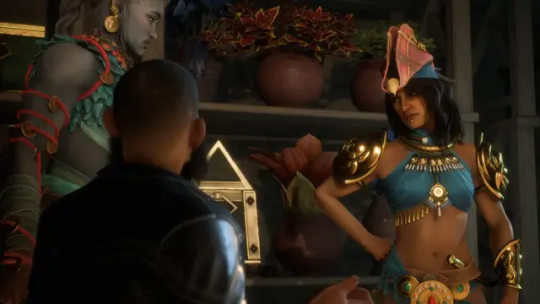
When these rogue buccaneers aren’t busy giving land acknowledgments to displaced Dalish elves or whatever, they’re enjoying their nonviolent coliseum. Pirates revel in bloodsport, but only so long as no actual blood is spilled. The Lords refuse to fight prisoners or animals in their arena, as they find such acts too cruel. I guess they’re all big Peter Singer readers. Instead, they summon spirits to adopt the visages of common enemies so that the player can kill them with a clean conscience. It’s another example of wanting to have your cake and eat it too – they wanted to create a glory hunter/gladiator faction, but couldn’t stand the underlying implications of such. So they twisted and bent them to fit into their unproblematic paradigm, leaving the Lords flavorless and lame. They barely even contribute to the main story, and they’re practically the only look we get into Rivaini society (which remains criminally underdeveloped).
More tragic is the handling of the qunari, once one of the most unique and nuanced civilizations in the Dragon Age setting. The Qun, as portrayed in the first three installments, is a society that demands all of its composite parts work in harmony. Thus, they have predetermined vocations for their children, rigid gender roles, strict codes of conduct, and an ambition to “enlighten” the rest of the world. While the Qun has often been presented as antagonistic toward the heroes, the series has commonly balanced its portrayal by showing how seductive its absolutism can be for people without hope. In some cases, life under the Qun is preferable, as is the case with former Tevinter slaves. Conformity becomes comfort when the world is regularly threatening to split apart.
The Veilguard opts for a different approach. See, Rook’s not fighting members of the Qun in this game – they’re fighting the Antaam, the former qunari military. The Veilguard constantly reiterates that the Antaam, which makes up one of the three branches of the Qun, has broken off and decided to invade, pillage, and stoke chaos. BioWare didn’t want the questionable morality and complexity of fighting an invading people from a humanized, multi-faceted culture, so they removed their culture. Their efforts to turn the non-Western-coded qunari into something digestible for their mistaken conception of a modern audience instead results in two caricatures: one being a fetishized, perfect society where there are no perceivable social ills; and the other a bunch of rampaging brutes.
Contending with a realized conception of Plato’s Republic mixed with the Ottoman Empire makes for more compelling drama than a horde of murderous giants. Again, BioWare wanted to have it both ways, and they still needed nameless, faceless orcs to kill. So every bit about the qunari’s militancy, imperialism, and repression coexisting alongside some of their more progressive ideas and communal unity is stripped of its context and meaning. Blame is placed solely on the Antaam, who no longer represent (and retroactively, never represented) the Qun’s ideology. It’s a cowardly compromise, attempting to pin the blame of all the Qun’s failings on a renegade military and seeking to exonerate the political and social apparatuses of their culpability.
At one point, a minor character named Seer Rowan lectures to an ignorant human (a proxy for the audience absorbing these retcons) that qunari society has always been egalitarian in practice, with mages enjoying freedom there. Previous games showed that the qunari shackle their “saarebas” mages, stitch their mouths, cut out their tongues, and teach them to commit suicide if they ever stray from their masters. However, we’re now assured that this is only practiced under the Antaam, and No True Qunari would ever do such a thing. Ignore the fact that, in Inquisition, we witness the enslaved saarebas under the supervision of the Ben-Hasserath, a subdivision of the Ariqun (i.e. not part of the Antaam). In fact, the Antaam that Rook fights in The Veilguard never command saarebas at all. They’re completely absent from the game (likely because the image of the bound, mutilated minority was too much for The Veilguard’s sensibilities). Seer Rowan’s weak, conciliatory retcon can’t even justify itself in its own game. The scolding diatribe communicates an intrinsic misunderstanding of the Qun by the writers – namely, it continues the pattern established with the Antivan Crows that the mechanics of power in society are fundamentally good as long as aberrant forces aren’t in charge. While I understand the desire to be conscientious about the portrayal of fictional cultures that draw upon non-Western traditions and iconography (which have historically been demonized in media), glamorizing the Qun and stripping it of its realistic nuance does little to alleviate any problems with representation. If anything, it creates new ones.
But hey, now we have our faceless orcs to guiltlessly slaughter. That’s what the Antaam’s been reduced to, bereft of the ideology that made them people. We kill them because they’re strange and scary and foreign and seeking to destroy our cities for fun. They remain the most prominent representation of the qunari in-game, barring our party member Taash. BioWare’s attempts to reverse what they viewed as problematic components to the qunari instead devolved into the very tropes they wished to avoid.
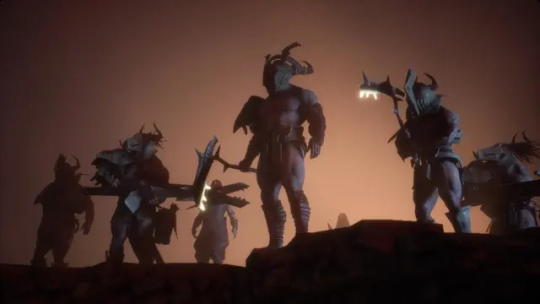
Which leads us to the elves. Much of the series’s discourse has surrounded the portrayal of the long-suffering elven people, who endure slavery under Tevinter, expulsion from their homeland in the Dales, confinement in ghettos, and the general disdain from other races. The games’ stories use symbolic shorthand of real-life oppressed peoples to communicate these tragedies, and this has led to a variety of intense, emotional interpretations over the years. The unending misery of the systematically marginalized elves hasn’t gone unnoticed by the fanbase – and their criticisms haven’t gone unnoticed by the developers. To quote The Veilguard’s creative director, John Epler, in an interview with Polygon:
“Dragon Age has not always been the kindest to the Dalish [elves]. Somebody once made a joke to me, and it’s not untrue, that it’s possible to wipe out a Dalish clan in all three of the games in some way.”
He and others on the development team must’ve thought elves needed a break, because the omnipresent racism against them vanishes completely in The Veilguard. Tevinter, an empire built on the back of chattel slavery, doesn’t show any of that. Consequently, it feels like players in the know still haven’t seen the true face of Tevinter, despite spending half a game there. The notion that the capital of Minrathous gives now is one of a prosperous city that’s centuries ahead of the countries down south, rather than a cruel regime cracking the whip at every opportunity. Perhaps the writers weren’t comfortable portraying this, or felt that their audience might not be amenable to it after years of incendiary argumentation. Nevertheless, it castrates their established world-building and robs us of the opportunity to witness true elven liberation in the climax. With both the fall of Minrathous and the toppling of the tyrannical elven gods, we could have delivered a much needed catharsis after four games of oppression, but The Veilguard forgoes this storytelling opportunity to play it safe.
I worry that this hesitancy originated from anxieties about the sensitivity of depicting marginalized peoples in brutal, dehumanizing conditions, and how that might look to more fragile viewers. But I think it’s important for all players, watchers, and readers to know that, though there might be aspects shared between them, fictional minorities are distinct from real ones.
Dragon Age’s elves are aesthetically Celtic. Their residency in alienages evokes images of Disapora Jews in Europe. Their Long Walk after being driven from the Dales calls back to the Trail of Tears, sharing an experience with Native Americans. Their subsequent migratory nature is reminiscent of the Romani people. And their ancient empire of Arlathan, with its large columns and temples of worship, headed by ascended humanoid (for lack of a better term) deities that cast down an enemy called the Titans, and which has since had its religion and culture co-opted and renamed by Roman-inspired Tevinter invites comparisons to classical Greece.
My point is, the elves of Dragon Age don’t represent one group of people, because fictional cultures are constructs drawing from countless inspirations. If they represent anything beyond themselves, it’s the idea of a proud people that’s fallen under the yoke of conquering powers – a supervictim to embody all. The idea that one must be limited in their storytelling options based on how the portrayal might reflect upon or disrespect an existing culture is flawed, in my opinion. In the overwhelming majority of cases, coding cannot be read as a 1:1 allegory, especially in speculative fiction like science-fiction and fantasy. I believe the most mature way to evaluate a story isn’t to try to pigeonhole what it’s trying to say say about who, as if there’s some insidious encrypted message in the text. Rather, it’s to see the forest through the trees and interpret the work as a complete whole in itself.
On that basis, I ask: would it have been so bad to see some of those enslaved elves, praying for salvation, side with their manipulative, nefarious gods? To add some nuance to the conflict with Elgar’nan and Ghilan’nain, would the story of elven liberation not have been better if the game actually engaged with it? Could we actually have a moral quandary with those whom Rook ends up fighting, even if the content might be seemingly problematic?
Epler might respond in the negative, per the Polygon interview, claiming that the gods “simply don’t care” about the elves.
“Those blighted, decrepit gods, they’re not bothering with the soft pitch. Their pitch is, We’re going to make a horrible world. We’re going to give you a lot of power, and maybe you’ll be OK.”
Like a chess board, the core conflict of The Veilguard is black and white. BioWare abandoned the chance to make Elgar’nan and Ghilan’nain more interesting villains because it was too risky.
Similarly risky was Solas’s role as an antagonist, since his motivations, as explained in “Trespasser”, are deeply sympathetic. Perhaps too much so for the developers’ comfort. Unlike the Evanuris and their disinterest in the elves, Solas wants to restore the elven people to their former glory. At least, that seemed to be his pitch in the last game. Frustratingly absent from The Veilguard are the Agents of Fen’Harel – elves who swore fealty to Solas’s cause. They infiltrated and compromised the Inquisition, effectively precipitating the final decision to end the organization in its current form. The idea that Solas had amassed an army of common folk who found the idea of a renewed elven empire appealing made him appear formidable and intimidating. “Trespasser” implies that a mass uprising of elves under Solas’s leadership was imminent, and anyone could be in on it.
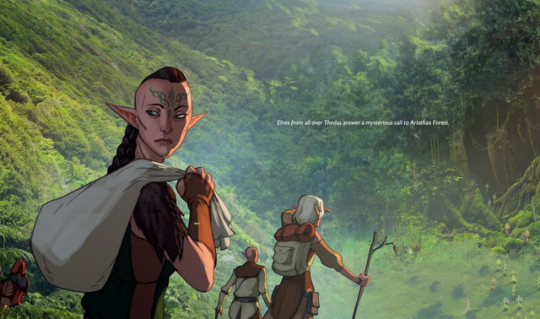
None of this happens in The Veilguard. Not only does Solas lack an army, but their absence isn’t explained or even acknowledged. As a result, Solas remains a passive antagonist until near the end, since the player has no disciples of his to contend with (either physically or ideologically) along the way. It wastes a side of his character that had been foreshadowed in a decade-long cliffhanger – that of a charismatic leader, capable of coordinating a rebellion that could spell disaster for its own followers.
In a Reddit AMA after the latest game’s release, Epler answered where the Agents of Fen’Harel disappeared to:
“Solas’ experience leading the rebellion against the Evanuris turned him against the idea of being a leader. You see it in the memories – the entire experience of being in charge ate at him and, ultimately, convinced him he needed to do this on his own. And his own motivations were very different from the motivations of those who wanted to follow him – he had no real regard for their lives or their goals. So at some point between Trespasser and DATV, he severed that connection with his ‘followers’ and went back to being a lone wolf. There are Dalish clans who are sympathetic to his goals, but even there, there’s an understanding that he’s too dangerous to have a more formal connection with, and that he will, ultimately, sacrifice them to his own ends if necessary.”
I find this explanation unsatisfying, not the least bit because the narrative offers next to nothing to imply this. The disappearance of Solas’s agents represents my biggest bugbear with the game, depriving it of the full potential of its highly anticipated antagonist in favor of the more generically villainous Evanuris. Moreover, this omission fits into the aggravating blueprint for The Veilguard’s inoffensive direction. The motivations, emotions, and backgrounds of the Agents of Fen’Harel would be sympathetic, and therefore might problematize the otherwise cut-and-dry conflicts. Epler seemed concerned that audiences might think Solas was “a little too sympathetic in his goals,” according to an interview with GamesRadar+.
But that’s the thing: sympathy isn’t endorsement, and portrayal of sympathetic characters isn’t endorsement either. But neither does that invalidate the emotions and experiences that generate that sympathy, even if the character’s actions ultimately turn toward evil. I’ve noticed a trend (especially in symptomatic criticism, which I generally dislike5) to view art as propaganda, and to evaluate it from a moralizing, top-down perspective. Antagonists with complex or understandable motivations (in this case, revolutionary villains) are often judged by this framework as tools for stories wishing to champion the status quo. Common arguments that I’ve seen imply that the relatability that we often find in villains is not a strength of the writing, but a devilish trick of ideology by which writers can reinforce conservative doctrine, to scold us away from certain beliefs. Any decent writer knows this isn’t the case, and that people don’t write morally or emotionally complex antagonists for didactic purposes. Instead, characters such as these embody the anxieties of their creators – the fear of losing yourself to your passions, the fear of going about things the wrong way, the fear of sacrificing too much to achieve your desired ends. The concepts and feelings that compel these characters remain authentic to the writer’s heart and the connection they established with the audience.
Art isn’t propaganda. To read it as such reduces it and promotes intellectual dishonesty and foolhardy myopia. Stories are irreducible (otherwise, we would not waste our time with them), and so I believe interpretations should be formed from the bottom-up, rooted in the text as much as possible. The “message” cannot be imposed from the top-down, but symptomatic readings, in their focus on tropes and cultural context, frequently condemn without a trial. Hindering your story in order to future-proof it for the sake of optics is a safeguard against this, and one that leads to bad stories. Artists should have confidence that their text will hold its ground on its own. To quote Ursula K. Le Guin’s essay “A Message about Messages”:
“The complex meanings of a serious story or novel can be understood only by participation in the language of the story itself. To translate them into a message or reduce them to a sermon distorts, betrays, and destroys them… Any reduction of that language into intellectual messages is radically, destructively incomplete.” (67-68)
BioWare’s doctrine of passive writing violates this wisdom by surrendering to their fear of (bad) criticism. The Veilguard lacks punch, stakes, and empathy and becomes incongruous with its established lore because it’s not willing to take risks that might alienate or upset players. They’re more concerned with making sure their work is inoffensive than they are with conveying a moving story.
I believe all of this was inherited from an incestuous feedback loop between a vocal minority of critics, of which I might’ve once counted myself among the blameworthy, and the apprehensiveness of out-of-touch corporate board room decision-making. Dragon Age’s genome mutated, and it slowly lost its teeth.
Over the course of a decade, we bred the Dread Wolf into a Dread Pug.
V. What It Took
The Veilguard’s lack of confidence in itself and lack of faith in its audience contribute to its capitulatory nature. In many respects, it feels like the developers lost their passion for it over the course of the ten year hellish production and just wanted to be done with it. This resulted in a decent game that nonetheless feels divorced from what came before it. It tries to juggle being a soft reboot while also trying to close out the series’s biggest and longest running story arcs, but inevitably fumbles.
Nearly everything done by The Veilguard was handled better by Inquisition. And Inquisition was certainly the more ambitious title. Perhaps more returning characters would have established a sense of continuity between the two, or at least made it less awkward by having them present for the story’s grand finale. For as strong as the endgame is, it could’ve benefited from the presence of slave liberator Fenris, elven history aficionado Merrill, possible Evanuris soul vessel Sera, or Divine Victoria (any of them). The core pillar of Dragon Age is the characters, and The Veilguard’s under-performance (and in some cases, outright dismissal) in that regard sabotages its integrity. Without this to anchor it, the changes to gameplay, visuals, and roleplaying depth become more alienating.
Personally, what do I take away from this? The Veilguard is far from the game I dreamed about for ten years, and not the one that loyal fans deserved either. I’m no stranger to disappointment at this point in my life, and yet this still leaves me with a hollow feeling. Will I still be able to return to Inquisition, a game I truly adore, and see it the same way as before, knowing now where all this is leading? The true cost of The Veilguard, for me, has nothing to do with the price tag: it’s the loss of that perfectly tailored dream, now that the possibilities of the future have shut their gates.
Where do those dreams go? Are they doomed to fester in their lonely, incommunicable agony? Will they be twisted by their enmity, like the blighted dreams of the Titans, and spread their corruption into those important happy memories?
In 2014, I was depressed as fuck, and Dragon Age: Inquisition helped me to see the light and come out of it. In 2024, I was depressed as fuck, and Dragon Age: The Veilguard made me feel nothing. There’s no less favorable comparison in my eyes. It’s disheartening to behold something that once meant so much to me and be greeted with numbness. I have to wonder if that affection will ever return, or if I’ve just grown out of it.
But as I wandered the streets of Minrathous as Rook, I heard a familiar song. It was one of the tavern songs from Inquisition, its nostalgic chords filling me with wistful sentiment. I know, deep down, there’s still something there. Maybe I just need to dig it up. Maybe it’s time to look back…
To be continued…
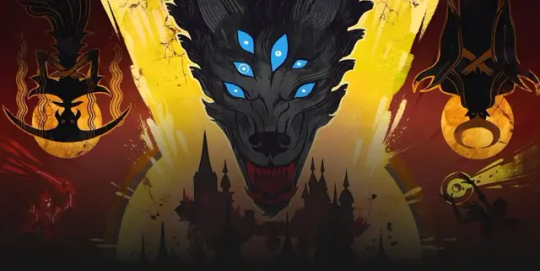
– Hunter Galbraith
Further Reading
Le Guin, Ursula K. “A Message about Messages.” Wonderbook: The Illustrated Guide to Creating Imaginative Fiction, Abrams Image, 2018, pp. 67–68.
Incidentally, this was an anomaly my friends and I pondered over and eventually solved. It turned out to be a former Wienerschnitzel. ↩︎
You could argue that this credit goes more to Inquisition and the previous games for laying the groundwork for said reveals, which were obviously planned out ahead of time, as confirmed by the aforementioned official artbook. Regardless, the payoff satisfied me and gave me proper closure. ↩︎
I’ve been informed that there is a hidden conversation that explains that the Lords of Fortune do, in fact, sell cultural artifacts at times, but only to the rightful owners. This just makes me wonder what they do with the artifacts if the prospective clients can’t pay. Do they shove them back in the ruins and re-arm all the booby traps? ↩︎
I would argue that this does not represent character progression on Isabela’s part, as her (possible, depending on the player’s choices) return of the Tome of Koslun in Dragon Age II was a pragmatic sacrifice she made to save her friends and the city, rather than an acknowledgment of the qunari’s inviolable ownership. In fact, in many continuities, she never returns the Tome at all. ↩︎
I prefer more formalist criticism because it allows the text to lead the dance, not the critique. I think it’s only fair, given that the creators likely spent more effort crafting the piece than I spent consuming it. Symptomatic criticism mandates that the reader consider everything around the text, typically at the text’s expense. In the worst cases, symptomatic critics make their arguments about seemingly everything besides the text in question. ↩︎ Link to article: https://planckstorytime.wordpress.com/2025/01/01/dragon-age-the-veilguard-strangled-by-gentle-hands/
#planckstorytime#writing#analysis#essay#dragon age#datv spoilers#datv rook#dragon age veilguard#veilguard#dragon age inquisition#solas#lace harding#bellara lutare#davrin#elgar'nan#ghilan'nain#neve gallus#taash#lucanis dellamorte#emmerich volkarin#video games#rpg#bioware#dragon age 4#dragon age dreadwolf#da4#tevinter imperium#dorian pavus#inquisitor lavellan#solavellan
292 notes
·
View notes
Text
Day 180: Not Pounded By Self-Doubt Because I Can Do Anything I Set My Mind To
Ok, from the title I was expecting this to be a broad feel-good tingler. I wasn't expecting it to hit me in a personal place. So this post will get kind of personal.
I wish I had read this one earlier! Close to the beginning of this project I made a post about how I hoped to get some inspiration to be creative again from reading all these tinglers. I don't have any aspirations of making professional-grade work like the protagonist of this story... I just missed being able to channel my feelings into hobbies I used to enjoy. I don't think I was able to put voice to exactly the problem for all those years- I thought I just couldn't think of ideas anymore. That wasn't it, though. I was feeling exactly what the protagonist of this story was feeling- self-doubt over the quality of his ideas. They were all too ridiculous, or too niche, or not fleshed-out enough (when you've gone creatively stagnant it's so easy to forget how those inklings of ideas have a tendency to develop themselves once you get down to actually writing/drawing them out!)
But, while I feel like this tingler is a great one for anyone feeling this way with their creativity... I think tinglers in general, especially the act of opening oneself to enjoying them without any feelings of irony, can be just as powerful. For fuck's sake, I read a story where a guy named Rim Tuesday fell in love with and had sex with a sentient veggie burger. And I LOVED it. And I could tell the author had fun writing it! Who's to say any idea is too ridiculous when the work I just described is an incredibly enjoyable one?!
Recently, I've gotten back into writing fanfiction. Slowly, but it's a start after letting the self-doubt keep me down for so long. It's fun! And this tingler makes me feel good about picking the hobby back up. This tingler is a good reminder that the fun I'm having with the ideas (hardcore lesbian sex between video game characters mostly, to be clear) makes it worthwhile no matter how far what I'm doing lies beyond what popular opinion would call "good" or "respectable" art.
516 notes
·
View notes
Text
Sims In Bloom: Generation 2 Pt. 197 (Furever Friends)
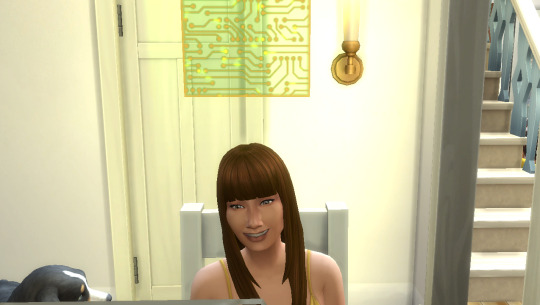
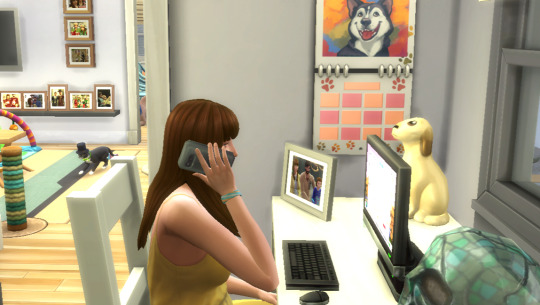
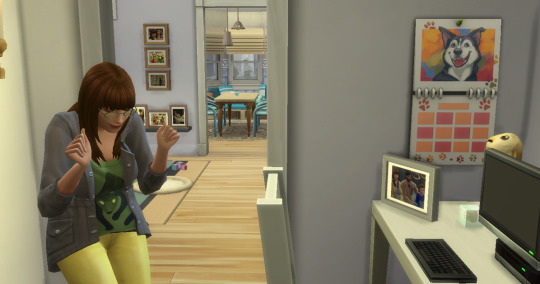

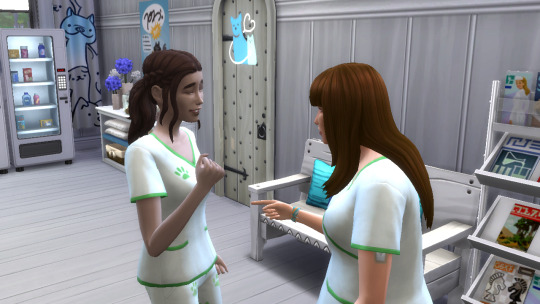
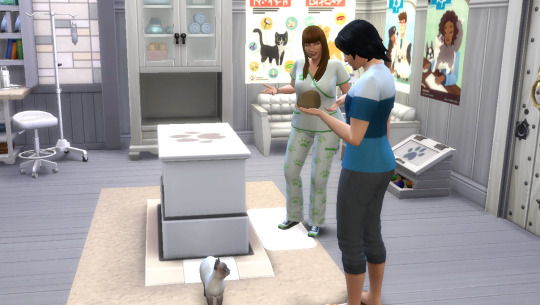
Heather finally finished her video game in the early days of summer. Furever Friends: Stray Valley was an instant hit, giving her notability as a newcomer to the gaming development scene.
She remodeled the roof with the game's windfall, but techie Heather wasn't really interested in the perks of fame. She wasn't even that interested in meeting calls from fans for an immediate sequel - designing the first had taken years, and she felt more fulfilled building on the success of Buttercup Pet Clinic.
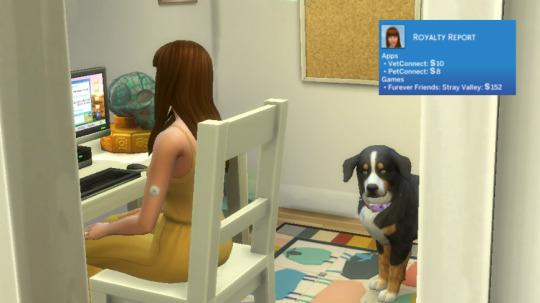
But Heather was still a geek at heart - designing video games may not have been her calling, but she couldn't resist writing a companion essay to release alongside the video game, about each of the stray pet characters who travelled the earth in search of 'furever friends.'
It was a niche project for only the game's most hardcore fans, but the work made her excited after long hours writing mind-numbing code for the game itself.
(Heather randomly rolled 'write an essay on niche fandom' for a bucket list want because of her geek trait, and I thought diving into the lore of her own video game was suitably niche!)
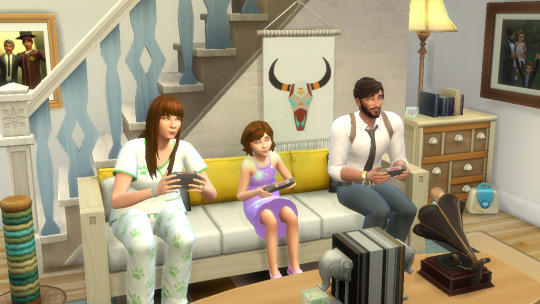
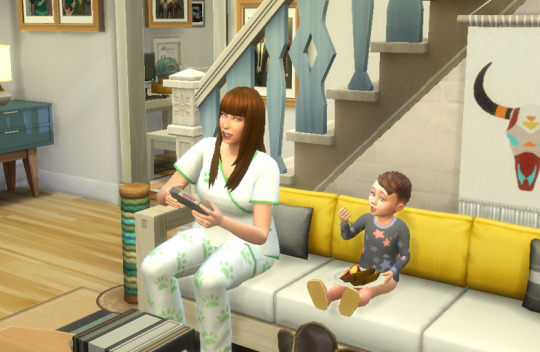
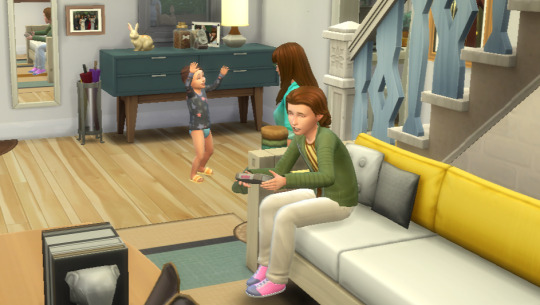
She was also thrilled to be able to sit down and play the game with her family. Roan was still too young, but she spent hours challenging Conrad, Ash, and Lavender.
Because she knew the code by heart, she usually let them win, taking more joy in watching them explore the game world - conceptualized by @igglemouse's talented artist Marisol Quesada, and mentored in execution with the help of @oimygiblets' overachieving genius (Cali Skye's younger brother!), Calvin Anthony Jr.
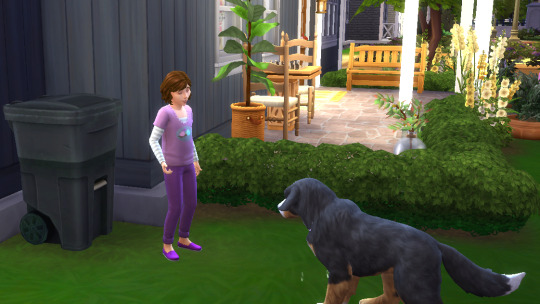

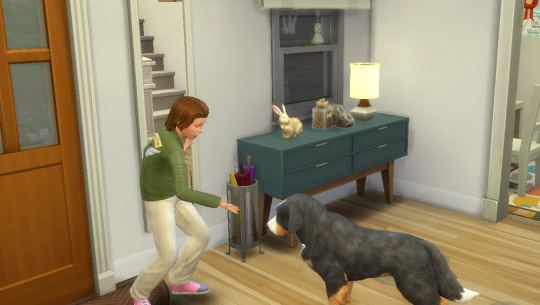
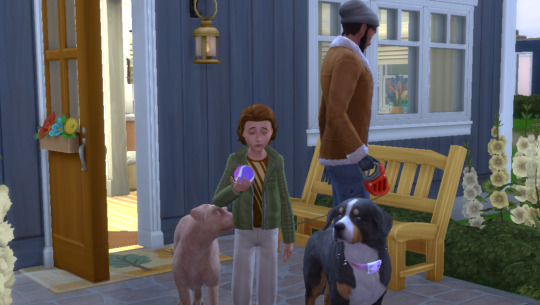
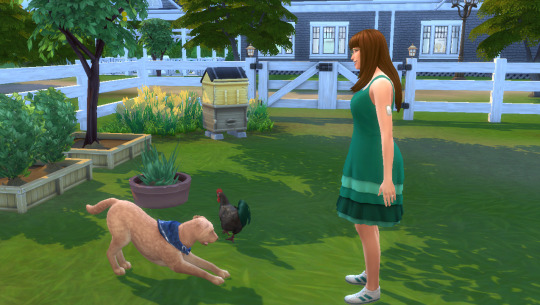
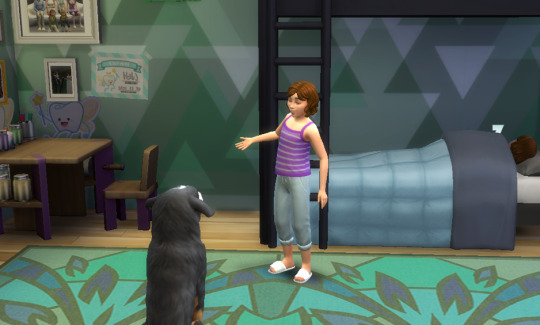
The family spent plenty of time with their own 'furever friends,' too. Both dogs, Gord and Captain Whitaker, were loving and friendly pets, following their humans everywhere they went.
It took Heather a long time to teach their resurrected retriever to leave the chickens and the coop alone! Lavender and Gord were particularly close, and she often tried to convince him to help train out Captain Whitaker's bad habits.
A heat wave hit the Bay leading up to Ash's birthday. In the summer sunshine, Conrad helped his stepson try to master his bike. Ash could ride pretty well, but he wanted to be even better. (Spoiler: He didn't get the milestone, but I tried! His childhood was affected by forever winter, a kidnapping, discovering time travel...It was a lot!)
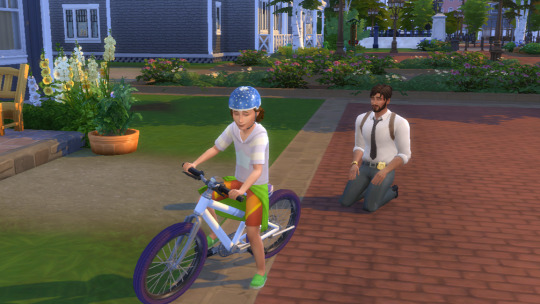
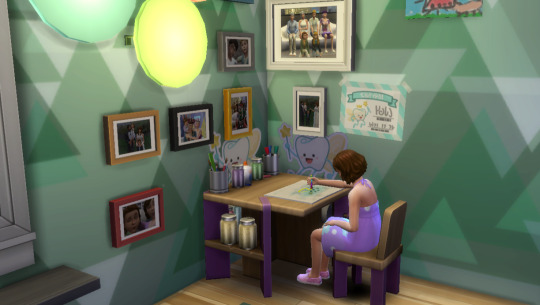
Artistic Lavender was often found doing arts and crafts when not practicing her violin. She'd even begun working on an extra credit castle diorama project like her older brother had done when he was younger. This excited her parents, because it gave the perfectionist something to focus on besides her missing idol, Layne Coffin.
Ash and Heather joined her outside with plates of food while she worked. Ash gave her tips to complete it when she asked, but mostly discussed plans for his upcoming birthday with their mother.
He intended to invite family to spend a day on Deadgrass Isle, but he also planned to invite his three closest friends - Arun Kalani, Scotti Holiday, and Pearl Richards was even planning to visit all the way from San Myshuno.
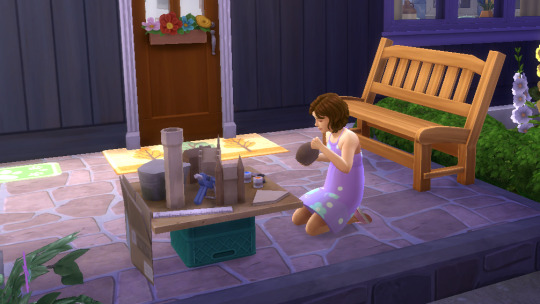
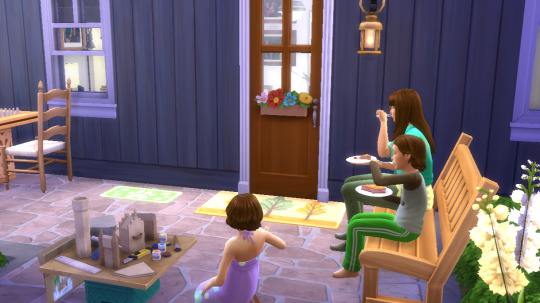
"San My Ballet Company is doing a performance of The Beauty and the Beast and she's the youngest professional in the whole show," he said proudly. "But she said they're not rehearsing on the day of my birthday because it's a holiday."
Heather smiled. "It's always great to see Pearl!"
"Do you think she's coming all the way out here for your birthday because she likes you? Like the girls who went all the way to Tartosa to date Deanna York!"
"We're friends, Lavender," he said quickly, shoveling another bite of food into his mouth. "She's too old for me; don't be weird!"
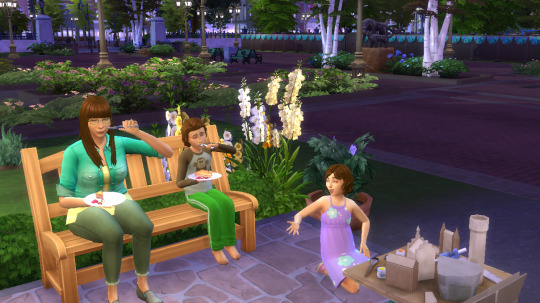
Without another word after a stern eye from her mother, Lavender returned to moulding precisely with her clay as the whirr of crickets filled the peaceful evening. ->
<- Previous Chapter | Gen 2 Start | Gen 2.1 Summary
Gen 1 Start | Gen 1 Summary
Once again, crediting @matchalovertrait and @opalsimmer for naming Heather's video game! It's iconic and I love it, thank you both so much! On a good day, she'll collect over 200 simoleons in royalties from this thing, too. If she actually liked programming, I'd consider that sequel!
#sims 4#sims 4 gameplay#sims 4 screenshots#sims 4 legacy#sims in bloom#ts4#ts4 gameplay#ts4 legacy#ts4 screenshots#sims 4 story#ts4 story#legacy challenge#sims legacy#ts4 legacy challenge#gen 2#brindleton bay
55 notes
·
View notes
Text
10 Years of Seven Ducks Studios!
One decade ago, I started making shitty RPG Maker games and Minecraft plugins. Eventually this lead to Wauzland, which was a fully functional RPG within Minecraft.
I also professionally developed commercial software, so there always was a steady stream of income to fund all the fun game projects.
Along the way, I created many other Minecraft minigames and random tools, like my own music player. Soon we merged Wauzland with Delseyria, which was the first time we had over 200 players in our community. "Delseyria Reborn" also exsits now, which isn't really actively developed right now, but will be continued one day.
In 2022, I announced "Elysian Eclipse", a small side project, with the goal to create a sandbox game, inspired by Spore. Well, it got a lot more attention than expected and the member count of our Discord server went from 250 to 1000 over night...
So, now I'm working full time on a funny creature game and also my own game engine, because fuck Unity! That surely was a long, strange journey and I want to thank everyone who helped me create all of these awesome things over the last 10 years!
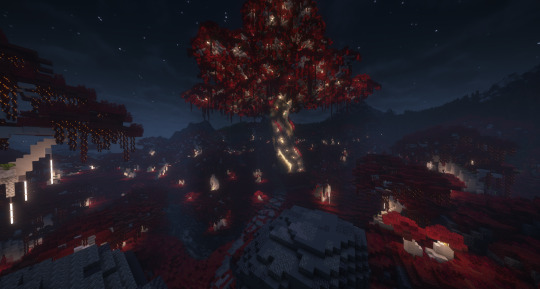
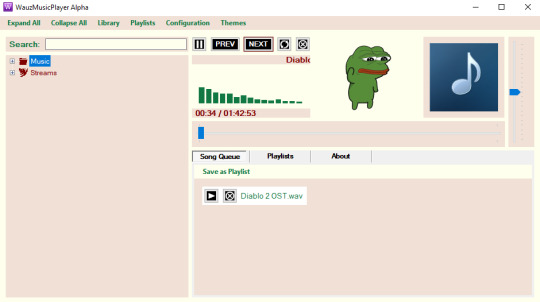
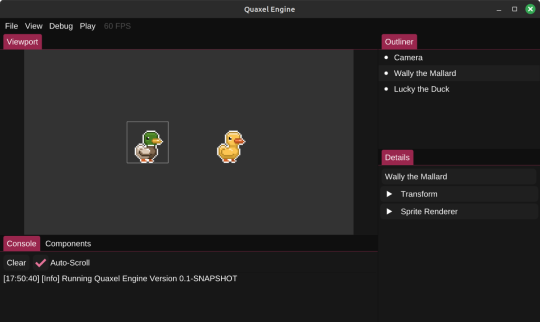
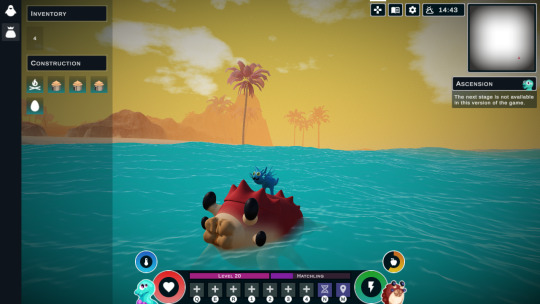
54 notes
·
View notes
Text

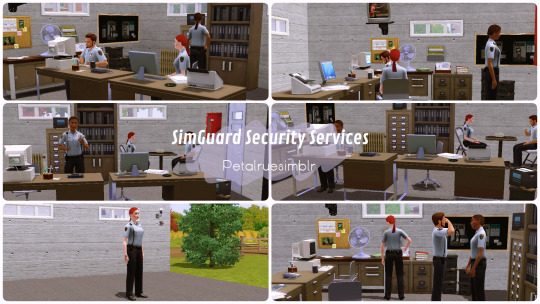
Hello and welcome back to my blog! I planned to post this about two weeks ago, but I got so busy with booking flights and reservations for my trip that I decided to wait until I returned from my vacation.
This project has been my plan for my next #FollowersGift and I’m happy that it's finally complete. It's not much, to be honest; this was just an idea I had for a career and I was unsure if I should create a part-time job again or pursue a full-time career, so I decided to do both!
The SimGuard Security Services is a full-time career based on a security company/firm while SimGuard Security is also part of that but is assigned to different lots. This took a while because aside from creating five part-time careers, I also created a full-time career that includes branches, opportunities and books, which will be fully discussed in this post. A second post will follow for the part-time careers so this one won't get too long.
Thank you to all my followers for the likes, reblogs, downloads of my content and all your kind comments! I truly appreciate each and every one of them.💜
If you are interested, click on ’Keep Reading’ below for more information and pictures of the SimGuard Security Services Career.
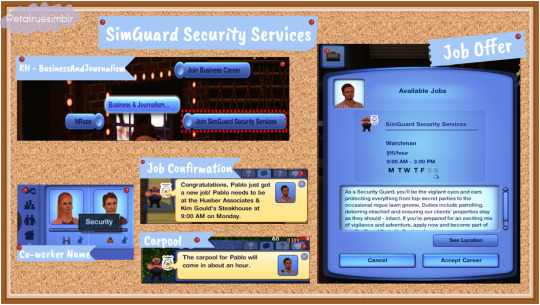
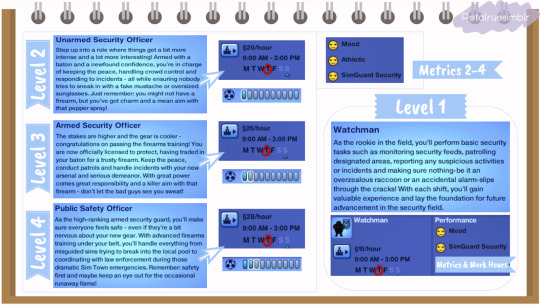
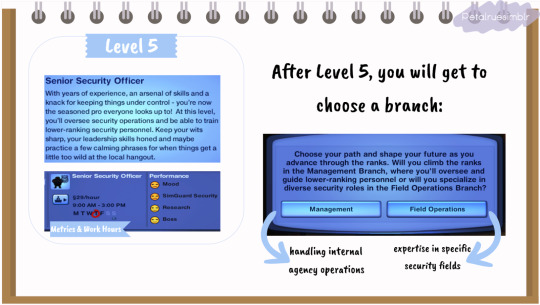
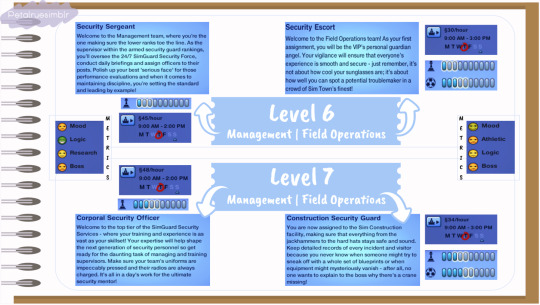
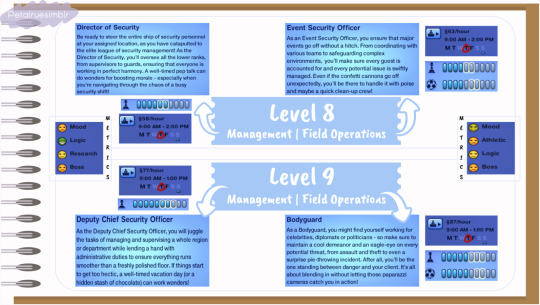
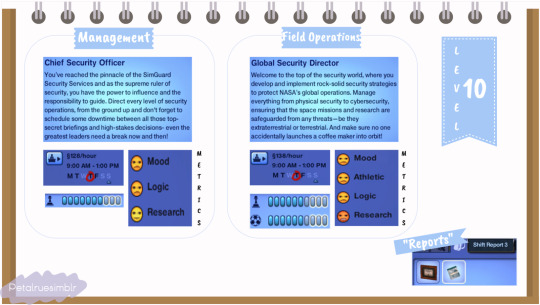

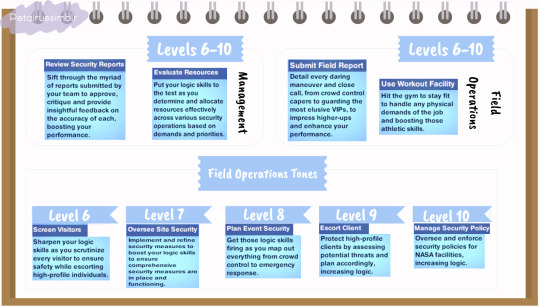
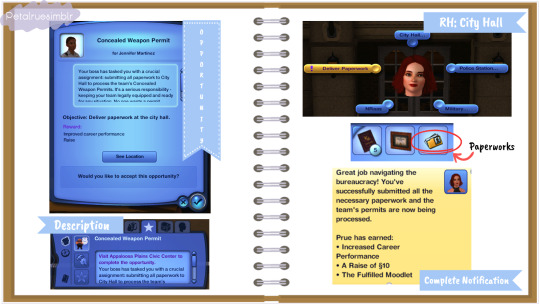


SimGuard Security Services

Bulk Download: Sim File Share (Full Time and Part-Times) | For individual files, refer to this post here.

As a Security Guard, you’ll be the vigilant eyes and ears protecting everything from top-secret parties to the occasional rogue lawn gnome. Duties include patrolling, deterring mischief and ensuring our clients’ properties stay as they should—intact. If you’re prepared for an exciting mix of vigilance and adventure, apply now and become part of our SimGuard Security Services!

Career Type: Full Time Available for: Young Adults and Adults Available Languages: English Levels: 10 Rabbit Hole: Business And Journalism Does it have Carpool? Yes Does it have Uniforms? Yes File Type: Package Min. Required Game Version: 1.42 Packs Needed: The Sims 3 📣All descriptions for the levels, tones and metrics as well as skills required, salary, uniforms and other details are provided on the pictures above. Right-click on a picture and select ’Open image in new tab’ for a clearer view.

NRAAS Careers Mod

Branches and wages: This career has two branches that branch out after level 5: the Management branch, which focuses on handling internal agency operations as you progress to higher ranks and the Field Operations branch, which allows for expertise in specific security fields. All the levels represent realistic roles based on the research I did for this career. If you prefer the managerial role, expect to read more reports and increase your logic skills. However, if you prefer roles like a bodyguard or security escort, expect to develop both athletic and logic skills as you take on different roles in the field. Levels 1-5 offer realistic hourly wages based on research. To compensate for the increased days off and decreased work hours as the level increases, I had to raise the hourly wages beyond the normal salary ranges for Levels 6-10 for both branches. Metrics and Books: I made a few changes to this career, specifically regarding the metrics. I originally planned to include "Reports" as part of the required tasks but I realized this was unrealistic since it was based on the Law Enforcement career, where individuals interview people, search through their trash and create reports based on those findings—tasks not typical for a security guard. Instead, I made it a custom tone and changed the "Reports" metric to "Research," which is based on the Medical career, where professionals read reports from their subordinates instead of medical journals. Opportunities: As this is my first time creating opportunities, I focused on developing just two for now, with only one of them being repeatable. This is because security guards need to complete a minimum number of hours of continued firearm training per year. I initially planned to include Martial Arts as part of the metrics but decided to make this base game compatible for now. I might release a different version for World Adventures but to be honest, I don’t have the time at the moment. You are always free to add it on your own for personal use (check my terms of use). Be sure to check out MissyHissy's tutorial under Credits for a step-by-step guide on how to do it. As stated above, you will need NRAAS Careers Mod for these careers to show up in the game and as long as you have the latest version of it, it should work for higher patches. You can also read my #psa regarding these careers, click here. I’m not fluent in any other languages to translate so if anyone is interested in translating this career, please don’t hesitate to send me a message here, comment on this post or let me know in my Ask/Contact form (if you don’t have a Tumblr account) and will let you know the details. I have tested this career in my game, so far it is working and all scripts are showing up. All feedback is very welcome to help me learn and improve my skills so please let me know if you experience any problems on your end and I’ll do my best to sort it as soon as possible.

MissyHissy step-by-step tutorial Twallan for the Career Mod S3pe
#petalruesimblr#custom career#the sims 3#ts3#ts3cc#followers gift#sims 3#ts3 simblr#ts3 simmer#sims 3 download#sims 3 screenshots#ts3 download#ts3 mods#ts3 community#ts3 screenshots#ts3 career#the sims 3 mods#the sims 3 career
146 notes
·
View notes
Text
The best local underground music I heard this year:
really incredible folk punk rock; this track in particular is very upbeat with a bluegrass feel. perfect for fans of Heretic Pride or Goths-era mountain goats; Aria's voice and arrangements have a very similar quality. a friend of his in a different act described Coffin Salesman as "The best band in Boston"
Thou Merciless Graves is a concept project written by lead singer and guitarist Growler Graves (Caitlin) after two battles with breast cancer. The show is about a selkie whose skin is taken by a lighthouse keeper and her relationship with him as he tries to get it back. It won two huge awards at the Boston Fringe and involved a gorgeous cast of bioluminescent jellyfish (umbrellas) and eel (think Chinese dragon) and a lighthouse keeper on stilts in a yellow slicker, hunched over like a tumor. Not all the music is on spotify yet, but this will give you a taste of how amazing it is.
Eden is a freshman at Berkelee and all her players are incredibly talented young students as well! The production value is probably the closest to professional as anyone on this list; Aruna's influences are in the wheelhouse of Billie Eilish and Clairo. Dreamy, breathy, longing-pop.
This is the title track and final track on my friend Justin's album which just came out a few days ago. We actually met at a Mountain Goats show, but by contrast Justin favors the more stripped, acoustic, Zopilote/West Texas sound. She and her girlfriend have such an enviously lovely queer community atmosphere developed out in rural MA where they just opened a performance space. Really the GOATs of lifting up fellow queer creatives and fighting the power.
My friend Aria of Coffin Salesman does a music discovery podcast and this is just hands down my favorite song he's ever shared. So good.
Bluesy, romantic offering from my friend and coworker Tyler who has written and sold songs for one of the most achingly romantic voices on the radio right now... though I won't say who 🤫. "The names" are also all really incredible players; the organist in particular does some really incredible stuff all over their spotify. This song is one of their gentlest offerings; they can really turn it up to 11 on the chaos.
Currently touring America, this guy is fucking nuts. Confessional, personal folk punk kind of like if Kimya Dawson were a little bit older and a little more nuts. This is an incredible album.
Outta Western MA, this guy has the cacophonic elements of Tyler and the Names with the orchestral sophistication of Neutral Milk Hotel or Frank Zappa. It's hard to pick a single off this album, as its cohesive overall arc is a huge part of it, but if you like the taste you should listen to the album beginning to end. Chris performs in a ski mask and the performances are often rearranged, interactive, and one-of-a-kind, with many props, lights, etc.
More stripped acoustic confessional folk punk sung by a whiny voice; do you think I have a type? 🤔 lmao.
This guy is 4 years sober after being really really big in the scene and falling hard. These days his stuff pushes the limits of the form, much like the Leafies but in a very different way. Chris is an incredible poet with an incredible voice.
Closing it out with another big party banger like White Girl, Wasted. Originally from Scotland, I saw Goodbye Blue Monday's first US show when they opened for Coffin Salesman. Good classic rock to thrash around to about experiences being bipolar and such. Really good fun.
what was really special about this is that I started going to shows chiefly to see my friend Tyler (Had to Let You Know) and discovered everybody else by meeting other acts on the bill, following them on insta, and going to their shows, on this incredible self-fulfilling upward spiral feedback loop tailored to taste.
most of these songs have <2000 streams on spotify, so they're really quite small, and your listening to them makes a huge difference! so thank you if you give them a chance 🖤 I have had the time of my life discovering the scene and I can't wait to share more with you. And feel free to drop a line in my ask box letting me know what you think!
33 notes
·
View notes
Text
Code Pizza
Leon Kennedy x fem reader Established relationship, fluff 1,531 words
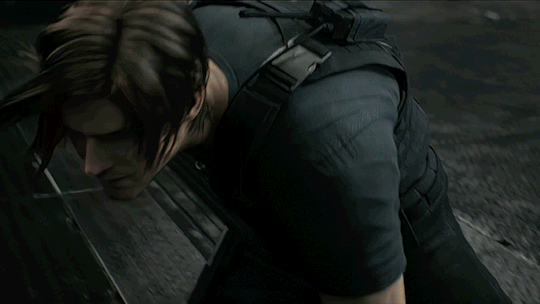
“Can’t you go any faster?” The barrel of a gun is pressed against the already tender spot from where they’d oh-so-kindly whacked you round the head earlier and you wince, losing the slight flow you’d managed to build up on the keyboard – Leon’s words echoing around your head.
“Promise me you won’t ever do any of that self-sacrificing bullshit,” he’d mumbled in your ear, arms wrapped around you in bed. He’d got back from a mission that afternoon – been awful quiet about what it had entailed, what had happened and you hadn’t pressed.
“Me?”
“Mm. Like, if… If someone’s forcing you to do something – do it, we’ll sort out the mess later. You make sure you’re home and alive at the end of the day.” His voice sounded almost strained. “Just promise me, sweetpea.”
“I promise.”
Not exactly sure if this scenario was exactly what Leon had had in mind, but there’s a gun and a threat, so you’re typing… or at least attempting to.
“She’d be faster if you’d untied her hands.” Hunnigan grumbled from behind, seated in an office chair with her hands zip-tied behind her back. Yours are bound in front of you, keeping your wrists crossed, and essentially cutting one hand out of action entirely.
“Is that true?” Your minder – A, you decide to call him - leans forward into your peripheral vision, though his face is obscured by a ski mask – as is his companion’s – B - standing over Hunnigan. They’re geared up to the nines, spare ammo dangling off tactical belts, part of a larger operation in order to gain access to DSO HQ and you, apparently. The doors are locked down due to the emergency protocol, though the HQ works on a skeleton crew at the weekend so it’s possible that no-one even knows you and Hunnigan are in.
“100 words per minute at my best.” You shrug, eyes skimming over the code you’ve managed to get through so far. “I’m probably working at… 15 and less. So, yeah, it would be faster.”
“Nice try.” B states. “You’re writing code, not a novel.”
“Novel, no. Poetry, maybe...” You trail off. It would be a lot easier if you did have both of your hands, weren’t being held at gunpoint and not suffering from a raging headache.
You weren’t even supposed to be working, it being a Sunday. You’d been in yesterday working overtime on a project, but this morning had been spent catching up on dull chores around the house – laundry, going to the store, cleaning - and then the plan had been an afternoon of video games on the sofa, ordering a pizza for dinner, accompanied by a bottle of wine. Leon had been away a couple of days on a need-to-know basis and you didn’t have a date of when he’d be back, though he did always try and give you a couple of hours’ heads up on his impending arrival.
Early afternoon, just as you’d sat down, controller in hand, you’d got a call. Not from your boyfriend, however, but from one Ingrid Hunnigan, extremely apologetic but there had been urgent developments – vague, as always – and she needed you in ASAP. You’d agreed, couldn’t really refuse her, but you’d decided in a slight show of protest you weren’t getting changed into your more professional work wardrobe. If it truly was an emergency, they’d have to deal with you in your jeans and t-shirt…
..which had led to the nasty bruise on your temple when the intruders had burst in, taking you as a civilian to be subdued. When you came to, hands now bound, head thudding, fingers being snapped in front of your face to get your attention, you were wheeled in front of the computer terminal and given your objective.
“It’s faster in the movies.” A comments, waving the gun lazily now at least.
“We’re not in the movies.” You grumble back, irritated. “I’m writing a bespoke code to get into this system.”
B comes to stand at your side, then. “Well, our contact promised us that you were some sort of genius at this sort of stuff.”
“Maybe when I’m not concuss-” You’re cut off by him slamming his fist on the desk besides you, making you jump and your heart pound.
“Enough lip, enough excuses. Concentrate.”
You shuffle in the seat, repositioning your hands and continue on with what’s been demanded of you, Leon’s words echoing in your mind.
Your phone emits a jingle from your pocket – speak of the devil…
“What’s that?” B demands, looking around.
“It’s my phone – just a text.”
“You were meant to search her, you idiot.” B chides his companion. “Where is it?”
“Jacket pocket.” It chimes again.
“Someone’s popular.” You bite your tongue as he crouches down besides you, placing a hand unnecessarily on your thigh as he dips his hand in your pocket, fishing it out. “Who’s LSK?”
“My boyfriend.” You don’t need to turn to know Hunnigan’s trying to hold in a grin.
“Says he’s on his way home, wants to know if you’re there.”
“Can you tell him I’m working late and he should order pizza for dinner? I haven’t been grocery shopping yet and I was meant to.”
“I’m not your secretary,” B scoffs.
The phone chimes again. You’d set Leon’s messages to that obnoxious sound to be sure you heard it, not wanting to miss a chance to text with him whilst he was away. If he had time on his hands, his texts often turned to stream of consciousness until he got a reply.
“You ignoring me, sweetpea? God, he’s a bit needy, isn’t he?”
“He’ll just keep doing it unless I text back,” you pause in your typing, “Or I can do it…”
“Ah-ah, keep working.” B replies, tapping at your phone’s keyboard.
It chimes again and B sighs.
“He wants to know what you want.”
“Er…” You hesitate a moment, pretending to doublecheck a string value. “Veggie. Extra jalapenos.”
He taps again and sends, before placing your phone down on the desk out of reach. His hand squeezes your shoulder and he leans in. “Keep coding like a good girl, and we’ll make sure you get home for that pizza.”
--
You don’t know how he managed it with the protocols in place – surely it means there’ll be another security review - but a mere 45 minutes later after ordering your pizza, Leon comes crashing down from the ceiling, taking out A and B with single, effective shots in the chest as he does.
He forward rolls out of the impact and gets to his feet with a flourish.
“Sorry for the wait, ladies, pizza’s free since it wasn’t 30 minutes or less.” He grins, heading to Hunnigan first and cutting through her restraints.
“Do I even want to ask?” Hunnigan quirks an eyebrow, rubbing her wrists. Leon walks over to you next, crouching down in front of you and cutting your wrists free. “Wait, extra jalapenos?”
“Bingo.” You reply, though unable to tear your eyes away from Leon – he looks tired, not unusual after returning from a mission, in need of a shave. He cups your face, fingers gently brushing over the tender spot on your temple to assess the damage. “It’s a dumb code, we know.”
“No, it obviously worked. Good thinking.” Hunnigan nods, getting to her feet and approaching another terminal, sliding in her keycard to overrule the emergency controls and release the doors. “I need to call this all in – get it tidied up. Did you gain access?”
“No, couple of lines away, though.” You look at the lines of code on the screen. “I did spend a lot of time to make sure it had a real nice interface for when I ran it, for extra pizazz.”
“Good work – both of you.” Hunnigan turns to face Leon directly then, “Make sure you keep an eye on her - took quite a hit.”
“I will. Thanks, Hunnigan.” He remains crouched at your feet, your hand in his, squeezing it reassuringly.
“Good. And don’t come into tomorrow – either of you. I’ll deal with… this.” She strides out with purpose, shoulders back, nothing alluding to the fact that she was a woman who’s been held hostage for the past however many hours.
“You good, sweetheart?”
You smile, staring deep into those blue eyes you adore. “I’m good. You?”
“Won’t lie, not quite the homecoming I expected. Come here.” He pulls you up out of the chair and against his chest, wraps his arms around you and kisses you frantically, though you know it’s in relief.
“Had me worried with those jalapenos,” Leon admits, softly.
“I kept my promise.”
“Mm, not quite.” He pulls back and grins – you know that grin – but you still let out a squeal as he hooks an arm under your legs and picks you up in his arms.
“Leon, I can-“
“Nah, your promise isn’t kept and my mission isn’t over till you’re home. Allow me to give you the full hero experience.”
You roll your eyes, before pressing a kiss to his jaw.
“Fine. But we’re still getting pizza.”
“Took the words outta my mouth, sweetpea.”
--
Comments, likes and reblogs make my whole day x
Masterlist . Requests welcome . Ko-fi
537 notes
·
View notes
Note
How expensive is voice acting (assuming professional actors with experience)? What amount of budget goes towards it? If there is a way to determine that, of course. I realize it probably depends a lot on the project. I'm looking at SWTOR which seems to be really struggling to afford VO these days, opting for unvoiced dialogue and even replacements of the main cast. Is it really taking that much of its budget (which is probably on the lower end these days) or is there some other factor at play?
Voice acting has a lot of associated costs. Specifically, getting the voice acting requires us to pay for:
The voice actor's time
The recording studio time
The voice director's time
The developer time
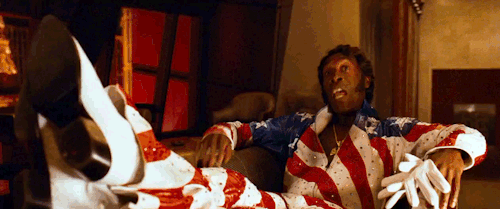
These can add up - we pay union voice actors about $2000 per day each according to the current [SAG-AFTRA interactive media contract rates], and we spend at least that much for studio time. We also need to factor in the time the developers are away from the development studio and are at the recording studio because they aren't doing their normal tasks while taking care of this. It isn't uncommon for voice recording to cost over $10,000 per day, all things considered.
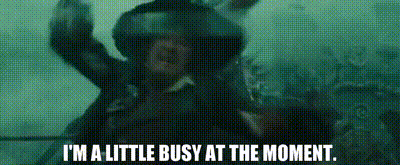
In addition to this, voice actors are often quite busy. They often have many roles already scheduled that they have committed to. This means that they might have only one or two days they can commit to recording, then be unavailable for months after that. In such cases, it means that we can't make any modifications or changes to the script after the recording is done because the voice actor isn't available to do those lines anymore. For example, take a look at [Aleks Le's IMDB page]. He did a lot of voicework for games like Persona 3 Reload, Street Fighter 6, Octopath Traveler 2, etc. I count 18 separate projects he recorded for in 2023 alone. If he's one of my voices, I probably wouldn't be able to get him back in the recording studio for several months since his schedule is so packed.

SWTOR is especially difficult to record for because player voice lines need to be recorded once for each character class. That means aligning eight different actors schedules before a hard deadline, and that can be extraordinarily difficult. Anyone who's tried to schedule events knows this - things happen, people change, agreements fall through, things get pushed back. As such, it's a small miracle they're able to keep putting out fresh voiced content like they do.
[Join us on Discord] and/or [Support us on Patreon]
Got a burning question you want answered?
Short questions: Ask a Game Dev on Twitter
Long questions: Ask a Game Dev on Tumblr
Frequent Questions: The FAQ
108 notes
·
View notes
Text
Presenting "Actor Falls" AU
So, as far as I am aware, no one has done an actor AU solely for Gravity Falls. Orxinus and Fazfuri do have a collab actor AU, however it's based off of their AU's exclusively and not the show itself. So, I decided to become the (maybe) first one to create one for Gravity falls.
General Gist:
My AU "Actor Falls" is set within a "Who Framed Roger Rabbit"/"Once Upon a Studio" type universe where humans and toons act together to create cartoons and fictional entertainment. Dipper, Mabel, Stan, Fiddleford, Ford and the rest of the human cast of Gravity Falls are, well, humans. Bill, the henchmaniacs, and all of the other supernatural creatures, meanwhile, are toons — cartoon characters who exist as real people in the world. They are all employed by the company Disney to work on the series.
Stanley and Stanford are biological, identical twins (just like how they are in the series), while Dipper and Mabel aren't actually related. They didn't know each before being cast with their roles, but quickly developed a close bond as if they were genuinely siblings. Bill and the Axolotl also don't have powers of any sort; the amphibian isn't truly a god, and two-dimensional triangle isn't a dream demon.
Background Information:
In order to avoid weirdness, I'm not going to include any of the people who genuinely worked on the show in my AU. Instead, GF was written by Mickey Mouse and Oswald the Lucky Rabbit. They decided to project the evolution of their brotherly bond and relationship into the story — Mickey unintentionally ruining Oswald's chance for success, causing an accident that destroyed his brother's life, Oswald resenting him for decades, and the two of them coming together in order to defeat a threat larger than life. Everything that happened in "Epic Mickey" actually occurred, and Mickey had the game created out of the events in order to restore Oswald's heart by reintroducing him to the public. They won't be the focus of the AU, but they're still part of it as the writers of Gravity Falls in-universe.
In-Depth Details:
Originally, they were just going to have Stan act as a double for the mysterious other twin in the story and green-screen an extra pair of fingers on. That was until Stan told them that – conveniently — he had a twin with polydactyly. He discussed the idea of becoming an actor for the series to Ford and he was hesitant about it at first, unsure of how well of one he would be. However, with some encouragement from his brother and reminders that his acceptance would benefit everyone, Ford ultimately ended up agreeing to the role.
Unfortunately, once he started working he found out that Bill also happened to be an actor for the series. They're canonly exes in this AU. They used to date in secret because of the strong public hate towards human/toon relationships. But, in the end, the lingering guilt of doing something so 'wrong' caused them to break up. They still long for the other, but will never openly admit it. Not yet, at least.
The two of them have a mutual, silent agreement to keep their romantic past hidden, in fear of wrecking their reputations. Bill is better at masking his disdain and remaining love, since he's a professional actor, but Ford struggles, being the newbie. This ends up causing rumors and gossip about the two of them currently dating. This certainly isn't helped by their dymanic in the show and how they seem to put extra emotion into certain scenes.
~~~~~~~~~~~~~~~~~~~~~~~~~~~~~~~~~~~~~~~~~~~~~~~~~~~~~~~~~~~~~~~~~~~~~~~~~~~~~
More Content
#actor falls#actor falls au#gravity falls au#gravity falls#bill cipher#ford pines#gf bill cipher#gravity falls bill#gf stanford#gravity falls ford#gravity falls stanford#stanford pines#gravity falls stanley#stan pines#stanley pines#gf stanley#gf stan pines#gf dipper#gf mabel#gf ford#gravity falls mabel#mabel pines#dipper and mabel#gravity falls dipper#dipper pines#mabel and dipper#stan twins#billford#gf billford#gf axolotl
43 notes
·
View notes